Matador Network's Blog, page 24
July 23, 2025
You Can Literally Dock and Dine in Greater Fort Lauderdale. Here’s Where.
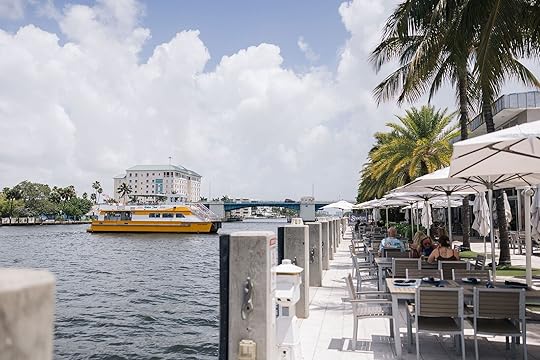
Twenty-four miles of pristine beaches and more than 300 miles of navigable waterways have earned Greater Fort Lauderdale two apt nicknames: the “Venice of America” and the “Yachting Capital of the World.” Boats glide past palm-lined canals, seagulls loop above marinas, and locals think nothing of tying up for lunch.
With so much life happening on the water, it’s no surprise waterfront dining is one of the area’s biggest draws. In Greater Fort Lauderdale, the best tables in town come with dock space — and a sea breeze. Here’s where to dig in.
Shooters Waterfront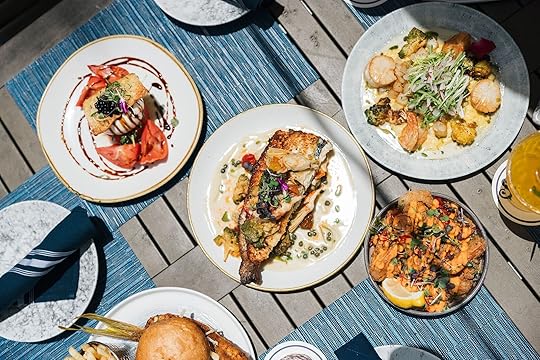
Photo: Scott Wild / Matador Network
Shooters Waterfront: 3033 NE 32nd Ave, Fort Lauderdale, FL 33308
Touted as the largest waterfront restaurant in Fort Lauderdale, Shooters has more than 350 feet of private dock space and 35,000 square feet of indoor-outdoor dining, which means plenty of room to drop anchor and unwind. Three bars help keep the energy high, while sweeping views of the Intracoastal Waterway seal in the vacation state of mind.
It’s a great spot for brunch, with top choices like the blue crab Benedict, huevos rancheros skillet, and sticky house-made cinnamon buns. But the appeal goes well beyond the morning crowd — the menu is broad enough to please everyone, even the family dog, thanks to a canine-approved menu featuring dishes like Bahia beef (USDA ground beef, whole wheat macaroni, butternut squash, organic carrots, apples, kale, pumpkin seed oil, and a blend of essential nutrients).
YOT Bar & KitchenYOT Bar & Kitchen: 2015 SW 20th St, Fort Lauderdale, FL 33315
Tucked inside Safe Harbor Lauderdale, this chic spot is all about serving classic American fare that’s elevated a notch. Sweeping marina views and polished nautical vibes set the tone, while diners can choose from dishes like an ahi tuna tower, wasabi shrimp Caesar salad, and swordfish with mint chimichurri.
The kitchen also caters to landlubber carnivores, serving up one of the best burgers in town — a Monday special for just $12 all day. If money is no object, pair it with a Millionaire Martini (Beluga Gold Line Vodka, caviar, gold flakes, fresh oyster, lemon, blue cheese olives). There’s also a solid cocktail menu and an extensive wine list.
Coconuts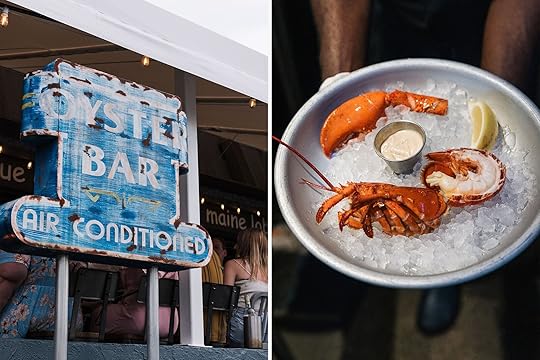
Photos: Scott Wild / Matador Network
Coconuts: 429 Seabreeze Blvd, Fort Lauderdale, FL 33301
This casual dockside staple calls itself a restaurant “even your mother-in-law will love.” With its fresh seafood and scenic Intracoastal views, you can assume it delivers. Begin with the restaurant’s legendary Scoobies — blue crab fried in enough garlic to keep the vampires (and possibly your dinner date) at bay — then move on to staples like the local mahi mahi sandwich, crab cake with creole sauce, coconut shrimp, or catch of the day.
Not into seafood? No problem. The daily steak preparation, oven-roasted chicken, and seasonal veggie plate have seafood skeptics covered.
The Southport Raw BarThe Southport Raw Bar: 1536 Cordova Rd, Fort Lauderdale, FL 33316
Where else can you find a bumper sticker that reads: “Eat Fish Live Longer, Eat Oysters Love Longer, Eat Clams Last Longer”? Started by two New Yorkers fleeing the cold more than 50 years ago, this bustling, no-frills Fort Lauderdale spot has earned its status as a local legend. As the name (and sticker) suggest, oysters and clams are the main event, but there’s plenty more to pair with a tropical cocktail or ice-cold beer, including a full hoagie section in case the craving for a Philly cheesesteak hits.
15th Street Fisheries
Photos: Scott Wild / Matador Network
15th Street Fisheries: 1900 SE 15th St, Fort Lauderdale, FL 33316
Locals profess that a visit to Greater Fort Lauderdale isn’t complete without a stop here. Housed inside one of Fort Lauderdale’s nautical landmarks, the Lauderdale Marina, this two-story eatery features two distinct dining experiences. Upstairs, the elevated, white-tablecloth dinner service is ideal for a special occasion or waterfront date night. Downstairs is all about shorts, flip-flops, and no reservations needed, with live music adding to the laid-back vibe.
No matter where you sit, seafood reigns supreme. Menu standouts include smoked fish dip, red snapper with coconut pineapple rice, and baked seafood pasta.
Rustic Inn CrabhouseRustic Inn Crabhouse: 4331 Anglers Ave, Fort Lauderdale, FL 33312
It’s hard to believe this sprawling seafood destination once began as a modest roadhouse saloon. A lot can change in 70 years, but the inviting water views, signature garlic crabs, and loyal regulars have remained constant. Diners are handed plastic bibs and wooden mallets before diving into the trademarked “World Famous Garlic Crabs.” (Note: Get ready for some noise and join in the tradition as patrons are encouraged to bang those mallets on their table!) There’s also a plethora of less messy dishes — including fried alligator, for those looking to cross that one off the bucket list.
Casablanca Cafe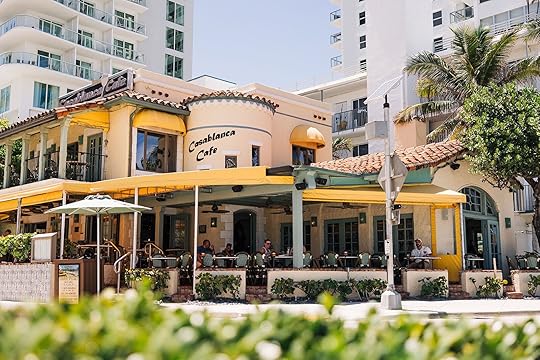
Photo: Scott Wild / Matador Network
Casablanca Cafe: 3049 Alhambra St, Fort Lauderdale, FL 33304
Hugged by the city’s modern skyscrapers, this popular date-night spot serves up picturesque oceanfront views from the patio of a historic two-story home (built in 1927) with a gorgeous winding staircase. The food lives up to the romantic, old-world name, with dishes like phyllo-wrapped baked brie with blueberry chutney, Moroccan lamb meatballs, filet mignon with red wine sauce and blue cheese potato gratin, and blue crab-crusted mahi mahi with beurre blanc. Truffle lobster mac and cheese beckons as a side, and you won’t want to skip dessert — chocolate lava cake with dulce de leche gelato or key lime pie are worthy indulgences.
Boathouse at the RiversideBoathouse at the Riverside: 620 SE 4th Street, Fort Lauderdale, FL 33301
Set along the New River in downtown Fort Lauderdale, this breezy spot with American-meets-Mediterranean fare makes for a perfect pitstop during a leisurely day on the water. Whether craving lighter dishes like the Boathouse crab cake, mahi tacklebox tacos, and Greek salad, or heartier fare like Mediterranean grilled salmon and shawarma grilled lamb chops, the waterfront setting is hard to beat. Ending with the five-layer chocolate cake is a no-brainer.
Marina Village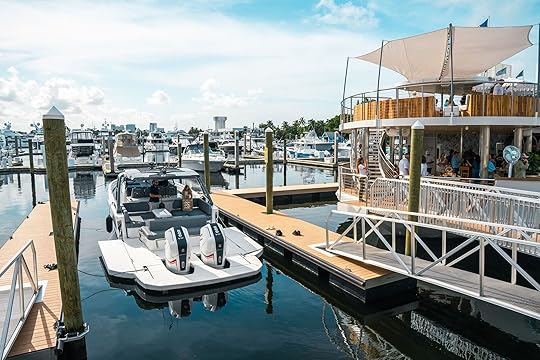
Photo: Marina Village
Marina Village: 849 Seabreeze Blvd, Fort Lauderdale, FL 33316
This open-air waterfront food hall offers eight culinary options with an ocean view. Craving dim sum? Head to YIP, where traditional favorites like shrimp and chive dumplings and steamed barbecue pork buns share the menu with playful twists like pepperoni pizza and chicken parmesan dumplings. Sushi Song offers an extensive selection of rolls and specials like the Poke Cup (choice of fish with house sauce, cucumbers, carrots, edamame, sushi rice, and seaweed salad served in a cup) and kimchi and shrimp fried rice crowned with a quail egg and fried onions. Fresh Garden Bowls keeps things light, while Burgers & Shakes is made for indulgence.
Stick around for sunset and claim a seat at the sleek 44-seat bar, where snacks and cocktails come with a front-row view of the sky’s nightly show. From there, move on to The Shorely, a 500-person ferry turned luxurious lounge and entertainment venue. For the quintessential Greater Fort Lauderdale experience, arrive and dock by boat, so long as it’s under 30 feet.
Casa SenseiCasa Sensei: 1200 E Las Olas Blvd STE 101, Fort Lauderdale, FL 33301
The only thing better than enjoying bold Latin and Asian flavors is doing it from a gondola. While most dock-and-dine spots invite you to tie up and head inside, this buzzy Las Olas favorite takes a different approach — serving up dinner right on the water via private gondola. Diners can book a ride that glides through the canals, complete with stargazing and slow cruises past Greater Fort Lauderdale’s most jaw-dropping waterfront homes — part meal, part real estate fantasy.
Start the ride with appetizers like charred octopus with mango-papaya salad and blue crab rangoon, followed by dim sum and entrees such as Mongolian duck, miso-marinated sea bass, and Korean steak with chimichurri. The “Latino” section of the menu brings the heat with Cuban tostones with shrimp, tuna guacamole, and Argentine beef empanadas. Sushi lovers can’t go wrong with any of the Sensei Specialty Rolls — or go all-in on the Million Dollar Roll, topped with lobster, scallops, foie gras, caviar, gold flakes, and truffle oil.
In Greater Fort Lauderdale, you never have to choose between a great meal, a beautiful view, and a day spent outside. Embrace the area’s dock-and-dine lifestyle, and you can have it all. 
The Best Airbnbs Near Vancouver’s BC Place for Soccer Fans

When the World Cup hits Vancouver next summer, BC Place — one of Canada’s flagship stadiums — will host seven matches, including two knockout-round games. This 54,500-seat venue, featuring the world’s largest cable-supported retractable roof, sits right in downtown Vancouver — just steps from fan zones, bars, and SkyTrain stops.
Whether you’re flying in from across the country or just making a weekend of it from elsewhere in Canada, we pulled together some of the best Airbnbs within walking distance of BC Place — all 20 minutes or less on foot from the stadium. They’re all a little different — some work well for groups, others are great for a cozy stay for two — but all of them place you smack in the middle of World Cup action.
We hope you love the Airbnbs near BC Place we recommend! Just so you know, Matador may collect a small commission from the links on this page if you decide to book a stay. Listed prices are accurate as of the time of publication.
Traveling to Vancouver for the World Cup? Check out Matador’s World Cup guides: Where to Eat, Play, and Stay During the 2026 Vancouver World Cup Matches The Best Hotels Near Vancouver’s BC Place for Soccer Fans The 7 Best Vancouver Soccer Bars for Watching the World Cup The Best Airbnbs in Vancouver, From a Skyhigh Loft to a Beachside Cabin The Perfect Vancouver Hotels to Experience the Best of the City Industrial-style loft for 2 guests with courtyard access Photo: Airbnb
Photo: Airbnb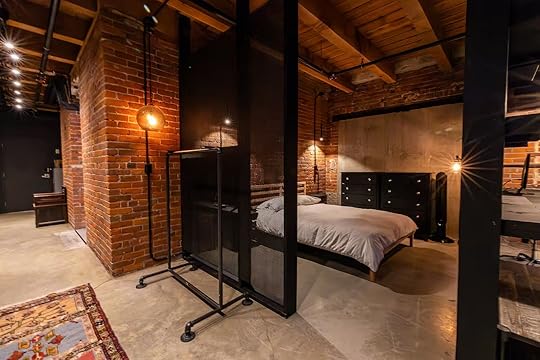 Photo: Airbnb
Photo: Airbnb Photo: Airbnb
Photo: Airbnb Photo: AirbnbSee more photos
Photo: AirbnbSee more photosDistance from Levi’s Stadium: 20-minute walk
Location: Historic Gastown, just northeast of downtown Vancouver and close to transit, dining, and nightlifeWho is this Airbnb for? Design-minded couples or solo travelers looking for a luxe home base near the stadium and restaurantsCapacity: One bedroom, one queen bed, one bathroom (plus separate toilet)Standout amenities: Soaking tub, open-concept shower, chef’s kitchen with gas range, in-suite laundry, shared courtyard with BBQs and a fireplaceWhat reviews say: Guests love the dramatic interior design, high ceilings, and proximity to the city’s best food and bars; consistently five stars and marked as a Guest FavoritePrice: $348 per night
Book NowRooftop-view condo with hot tub, firepit, and skyline views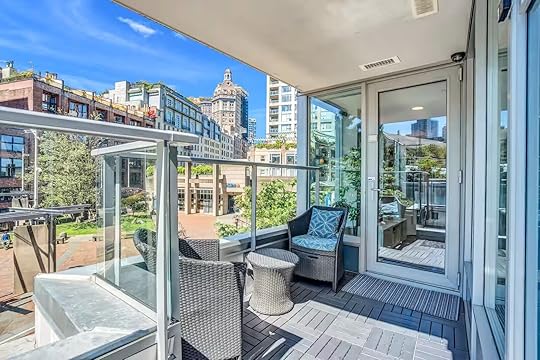 Photo: Airbnb
Photo: Airbnb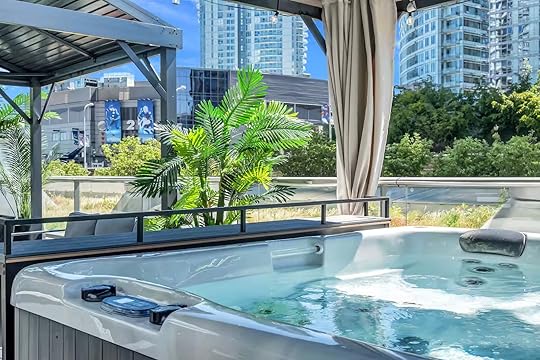 Photo: Airbnb
Photo: Airbnb Photo: Airbnb
Photo: Airbnb Photo: AirbnbSee more photos
Photo: AirbnbSee more photosDistance from Levi’s Stadium: 10-minute walk
Location: Across the street from Rogers Arena, minutes from BC Place, Gastown, Chinatown, and the SeawallWho is this Airbnb for? Groups who want post-match luxury on-siteCapacity: Two bedrooms, three beds, two bathrooms; sleeps up to sixStandout amenities: Private hot tub and fire table on a 400-square-foot patio, blackout blinds, two soaking tubs, portable AC, access to a shared pool and gymWhat reviews say: Ranked in the top 10 percent of listings; guests love the outdoor setup, and unbeatable location for stadium eventsPrice: $279 per night
Book NowPenthouse for 6 guests with a stadium-facing hot tub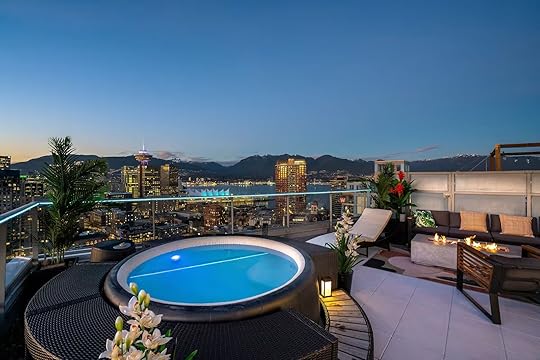 Photo: Airbnb
Photo: Airbnb Photo: Airbnb
Photo: Airbnb Photo: Airbnb
Photo: Airbnb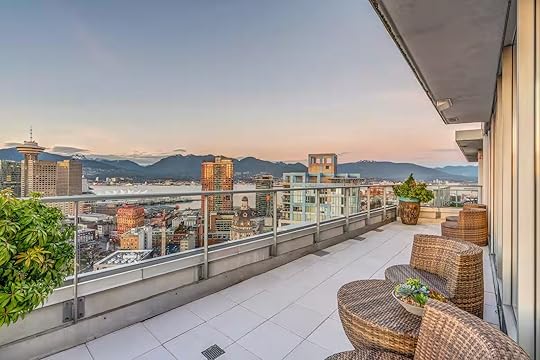 Photo: AirbnbSee more photos
Photo: AirbnbSee more photosDistance from Levi’s Stadium: Five-minute walk
Location: Downtown Vancouver’s Crosstown district, directly across from Rogers Arena and a five-minute walk to BC PlaceWho is this Airbnb for? World Cup fans traveling in groups or with family who want a front-row seat to Vancouver’s skyline, stadiums, and post-match hot tub hangsCapacity: Two bedrooms, three beds, two and a half bathrooms; sleeps up to sixStandout amenities: Private rooftop hot tub with ocean and city views, dining deck with fire table, blackout blinds, two balconies, in-unit laundry, and building amenities including a pool, sauna, gym, and courtyardWhat reviews say: Consistently rated five stars with a 4.99 average; ranked in the top ten percent of listings; guests praise the unmatched views, thoughtful host touches, and ideal stadium accessPrice: $605 per night
Book NowCorner-unit apartment for 6 with views and shared pool Photo: Airbnb
Photo: Airbnb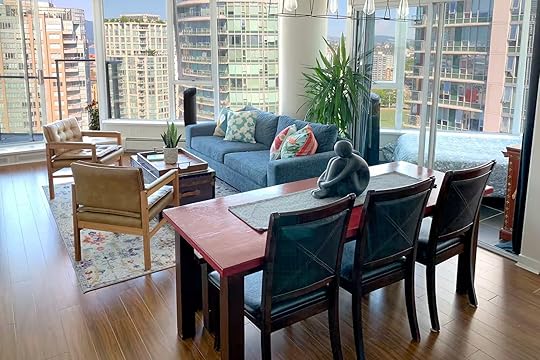 Photo: Airbnb
Photo: Airbnb Photo: Airbnb
Photo: Airbnb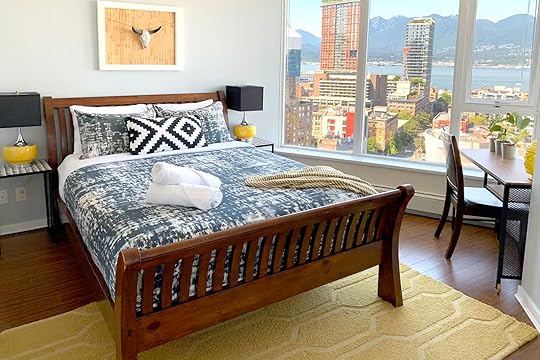 Photo: AirbnbSee more photos
Photo: AirbnbSee more photosDistance from Levi’s Stadium: 10-minute walk
Location: Downtown Vancouver, next to Rogers Arena and BC Place, steps from the Seawall, Chinatown, and GastownWho is this Airbnb for? Groups who want quick stadium access, skyline views, and plenty of space to relax between matchesCapacity: Three bedrooms, three beds, two bathrooms; sleeps up to sixStandout amenities: Private balcony with panoramic views, shared pool and sauna, in-unit laundry, and kitchen stocked with basicsWhat reviews say: Guest Favorite; praised for incredible views, responsive hosting, thoughtful extras, and secure parking right downtownPrice: $227 per night
Book Now1-bedroom heritage loft with king bed Photo: Airbnb
Photo: Airbnb Photo: Airbnb
Photo: Airbnb Photo: Airbnb
Photo: Airbnb Photo: AirbnbSee more photos
Photo: AirbnbSee more photosDistance from Levi’s Stadium: 20-minute walk
Location: Gastown, walking distance to Waterfront Station, Canada Place, and downtown restaurantsWho is this Airbnb for? Solo travelers or couples visiting for a match who want a stylish space close to the actionCapacity: One king-size bed, two guests, one bathroomStandout amenities: Fourteen-foot ceilings, exposed brick and beams, polished concrete floors, walk-in shower, courtyard with BBQs and outdoor diningWhat reviews say: Guest favorite with a rating of 4.99; praised for its design, comfort, and responsive hostsPrice: $251 per night
Book NowLight-drenched loft with views of Grouse Mountain Photo: Airbnb
Photo: Airbnb Photo: Airbnb
Photo: Airbnb Photo: Airbnb
Photo: Airbnb Photo: AirbnbSee more photos
Photo: AirbnbSee more photosDistance from Levi’s Stadium: 20-minute walk
Location: Historic Gastown, within walking distance to Waterfront Station, Chinatown, and downtown restaurantsWho is this Airbnb for? Couples or solo fans looking for a cozy, artful stay close to the stadium and city highlightsCapacity: One queen bed, one bathroom; sleeps twoStandout amenities: Large windows with skyline and mountain views, exposed brick and wood beam ceilings, record player with curated vinyl, secure building with lift accessWhat reviews say: Guest Favorite; visitors praise the calm interior, record player, and thoughtful host communicationPrice: $186 per night
Book Now2-bedroom downtown loft with parking and AC for groups Photo: Airbnb
Photo: Airbnb Photo: Airbnb
Photo: Airbnb Photo: Airbnb
Photo: Airbnb Photo: AirbnbSee more photos
Photo: AirbnbSee more photosDistance from Levi’s Stadium: 20-minute walk
Location: Downtown Vancouver in a converted 1906 warehouse, walkable to Waterfront Station and dining in GastownWho is this Airbnb for? Groups or families looking for extra space, entertainment perks, and on-site parkingCapacity: Two bedrooms (one king, one queen), one bathroom, plus sofa; sleeps up to fiveStandout amenities: Ceiling-mounted projector for movie nights, 16-ft ceilings, soaking tub and walk-through shower, AC, free underground parkingWhat reviews say: Guest Favorite with a 4.91 rating; guests rave about the loft’s character, secure building, high ceilings, and the “cinema-at-home” setupPrice: $384 per night
Book Now3-bedroom sub-penthouse with harbor views Photo: Airbnb
Photo: Airbnb Photo: Airbnb
Photo: Airbnb Photo: Airbnb
Photo: Airbnb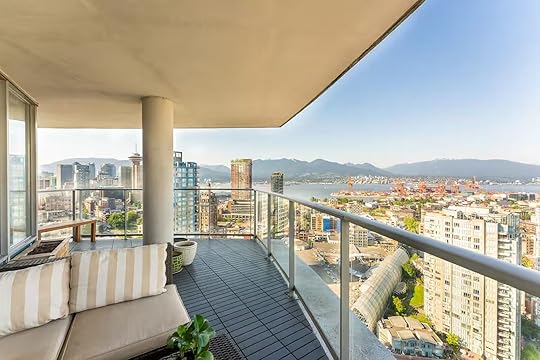 Photo: AirbnbSee more photos
Photo: AirbnbSee more photosDistance from Levi’s Stadium: 10-minute walk
Location: Downtown Vancouver’s Crosstown district, directly across from BC Place and Rogers Arena, with SkyTrain access below the buildingWho is this Airbnb for? Groups or families seeking comfort, convenience, and unbeatable match-day logistics in a high-rise escapeCapacity: Three bedrooms (one king, one queen, one single), two bathrooms; sleeps up to fiveStandout amenities: Sweeping water and mountain views, oversized balcony, piano, smart TVs in two rooms, optional secure underground parking, access to pool, hot tub, sauna, and gymWhat reviews say: Guest Favorite with an almost perfect score of 4.99 rating; guests praise the cityscape views, thoughtful host extras (like board games and Nespresso pods), and flawless location for events at the stadiumPrice: $559 per night
Book NowLuxury downtown apartment with 3 beds, pool, and secure parking Photo: Airbnb
Photo: Airbnb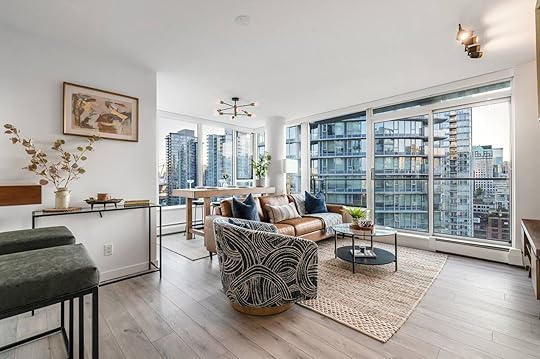 Photo: Airbnb
Photo: Airbnb Photo: Airbnb
Photo: Airbnb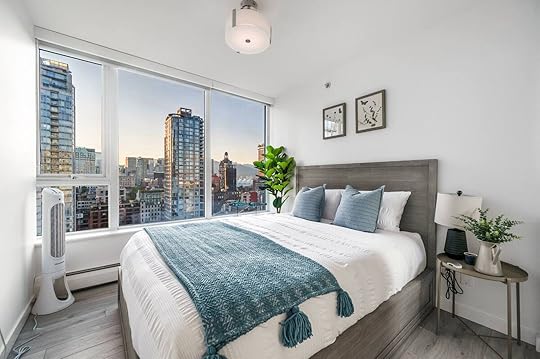 Photo: AirbnbSee more photos
Photo: AirbnbSee more photosDistance from Levi’s Stadium: 10-minute walk
Location: Downtown Vancouver, across from BC Place and a short walk to Rogers Arena, SkyTrain, and T&T SupermarketWho is this Airbnb for? Groups or families looking for comfort, walkability, and resort-style amenities during their time in the cityCapacity: Three bedrooms (one king, one queen, one single), two bathrooms; sleeps up to fiveStandout amenities: Bay and skyline views, 22nd-floor location, shared pool and sauna, access to a gym, free secure parking in building garageWhat reviews say: Guests highlight the panoramic views, thoughtful host support, and easy walking distance to stadiums and public transitPrice: $421 per night
Book NowPenthouse for 6 with huge private patio and rooftop hot tub Photo: Airbnb
Photo: Airbnb Photo: Airbnb
Photo: Airbnb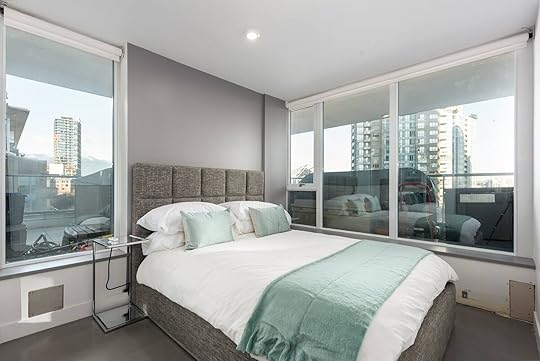 Photo: Airbnb
Photo: Airbnb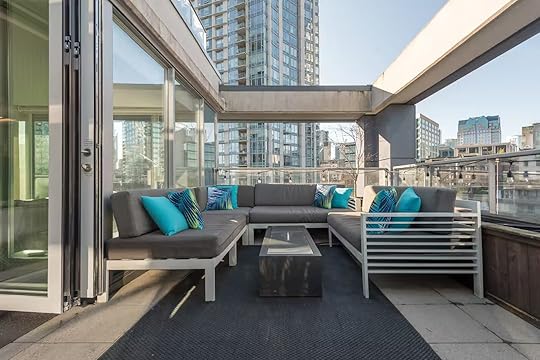 Photo: AirbnbSee more photos
Photo: AirbnbSee more photosDistance from Levi’s Stadium: 10-minute walk
Location: Across from Rogers Arena with direct SkyTrain access and walking distance to T&T Supermarket, Costco, and GastownWho is this Airbnb for? Groups seeking standout outdoor space, central access, and premium finishes in a private downtown settingCapacity: Three bedrooms (two king, one queen), two bathrooms; sleeps up to sixStandout amenities: Private patio with fire table, outdoor dining, gas BBQ, and seven-person hot tub; central air; secure parking with EV chargerWhat reviews say: Guests praise the host’s attention to detail, luxurious linens, walkable location, and rare private outdoor spacePrice: $658 per night
Book Now2-bedroom apartment for 5 guests with parking and gym access Photo: Airbnb
Photo: Airbnb Photo: Airbnb
Photo: Airbnb Photo: AirbnbSee more photos
Photo: AirbnbSee more photosDistance from Levi’s Stadium: Five-minute walk
Location: Quiet edge of Yaletown, a short walk to BC Place, Rogers Arena, the Seawall, and top restaurantsWho is this Airbnb for? Couples or small groups looking for clean, hotel-style comfort in a central, transit-connected areaCapacity: Two bedrooms (one queen, one double), two bathrooms; sleeps up to fourStandout amenities: In-building gym, in-suite laundry, modern kitchen, optional paid parking, self check-inWhat reviews say: Guests highlight the excellent communication, sleek design, and easy access to dining and transit
Price: $630 per night
Book NowJuly 22, 2025
The Best Airbnbs Near the Bay Area’s Levi’s Stadium for Soccer Fans

Summer 2026 will put Levi’s Stadium front and center for soccer fans worldwide, as the Bay Area prepares to host six thrilling FIFA World Cup matches — including an eagerly awaited knockout round clash on July 1.
If you want to be part of the action, now’s the time to start thinking about where you’ll stay. Instead of a standard hotel, consider one of the highly rated Airbnbs nearby that offer more space, character, and flexibility. Neighborhoods like Santa Clara, Sunnyvale, and Rivermark feature everything from sleek townhouses to roomy homes just minutes from the stadium.
To help you find a nearby stay and fully enjoy the World Cup experience, here are the best Airbnbs near Levi’s Stadium — giving you more time to cheer on your team and maybe carve out a few hours to explore the Bay Area between matches.
We hope you love the Airbnbs near Levi’s Stadium we recommend! Just so you know, Matador may collect a small commission from the links on this page if you decide to book a stay. Listed prices are accurate as of the time of publication.
Traveling to the Bay Area for the World Cup? Check out Matador’s World Cup guides: The Best Hotels Near the Bay Area’s Levi’s Stadium for Soccer Fans Where to Eat, Play, and Stay in San Francisco for the 2026 FIFA World Cup The 7 Best Soccer Bars in San Francisco for Watching the World Cup Top San Francisco Hotels Near the City’s Coolest Attractions and Neighborhoods These San Francisco Airbnbs Put You in the City’s Coolest Neighborhoods Airbnbs walkable to Levi’s Stadium | Airbnbs a short drive or rideshare awayAirbnbs walkable to Levi’s Stadium (30 minutes or less)4-bedroom Santa Clara home for 9 with outdoor space Photo: Airbnb
Photo: Airbnb Photo: Airbnb
Photo: Airbnb Photo: Airbnb
Photo: Airbnb Photo: AirbnbSee more photos
Photo: AirbnbSee more photosDistance from Levi’s Stadium: 25-minute walk, or a five-minute drive
Location: Santa Clara — blocks from Levi’s Stadium and close to Great America and local transitWho is this Airbnb for? World Cup fans looking for a roomy, casual home base with space to sleep nine and plenty of downtime perksCapacity: Four bedrooms, 2.5 bathrooms, accommodates nine guests across six beds plus a sleeper sofaStandout amenities: Backyard dining area, foosball table, driveway and street parkingWhat reviews say: Guests praise the walkable location, responsive hosting, and spacious setup — rated 4.78 overall with high marks for cleanliness and communicationPrice: $340 per night
Book NowBright 3-bedroom Japanese-inspired home with patio Photo: Airbnb
Photo: Airbnb Photo: Airbnb
Photo: Airbnb Photo: Airbnb
Photo: Airbnb Photo: AirbnbSee more photos
Photo: AirbnbSee more photosDistance from Levi’s Stadium: 25-minute walk, or a five-minute drive
Location: Santa Clara — one mile from Levi’s Stadium, with quick access to nearby parks, grocery stores, and Great AmericaWho is this Airbnb for? Small groups or families who want an easy-to-manage space with unique style and close stadium proximityCapacity: Three bedrooms, two bathrooms, fits eight guests — with two queen beds and two double bedsStandout amenities: Garden patio, Japanese design elements, single-level layout, designated parking plus street parkingWhat reviews say: Guests highlight the peaceful neighborhood, minimalist design, and walkability — near-perfect scores for communication and accuracyPrice: $241 per night
Book Now3-bedroom stay for 8 with private yard, foosball, and kid-friendly extras Photo: Airbnb
Photo: Airbnb Photo: Airbnb
Photo: Airbnb Photo: Airbnb
Photo: Airbnb Photo: AirbnbSee more photos
Photo: AirbnbSee more photosDistance from Levi’s Stadium: 30-minute walk, or a five-minute drive
Location: Santa Clara — one mile from Levi’s Stadium and the Convention Center, near Baylands trails and local diningWho is this Airbnb for? Families or groups heading to the stadium who’ll appreciate walkable access, kid-friendly features, and room for downtime between matchesCapacity: Three bedrooms, two bathrooms, fits eight guests — includes a California king, queen, two twin beds, and a sleeper sofaStandout amenities: Fenced-in yard, foosball table, high chair and baby gear, charcoal grill, converted garage gym with treadmill and deskWhat reviews say: Guests highlight the easy stadium walk, and blackout curtains for late sleep-ins — the home is clean, functional, and well-suited for families with kidsPrice: $192 per night
Book NowGroup-and-pet-friendly home with 4 beds, fenced yard, and parking
 Photo: Airbnb
Photo: Airbnb Photo: Airbnb
Photo: Airbnb Photo: Airbnb
Photo: Airbnb Photo: AirbnbSee more photos
Photo: AirbnbSee more photosDistance from Levi’s Stadium: 15-minute walk
Location: Santa Clara — walkable to Levi’s Stadium, near Great America and Ulistac Nature PreserveWho is this Airbnb for? Groups coming for the World Cup who want an easy walk to the stadium and lots of space for entertainingCapacity: Four bedrooms, three bathrooms, fits eight guestsStandout amenities: Fenced backyard, driveway and garage parking, ergonomic work setup, pet-friendlyWhat reviews say: Guest Favorite and rated five stars across the board — guests love the easy walk to the stadium, spacious layout, and prompt, helpful hostingPrice: $469 per night
Book NowAirbnb for 6 with smart check-in, backyard loungers, and stadium access Photo: Airbnb
Photo: Airbnb Photo: Airbnb
Photo: Airbnb Photo: Airbnb
Photo: Airbnb Photo: AirbnbSee more photos
Photo: AirbnbSee more photosDistance from Levi’s Stadium: 20-minute walk
Location: Santa Clara — five-minute drive to Levi’s Stadium, Great America, and Rivermark diningWho is this Airbnb for? Small groups coming for the tournament who want smart check-in, garage parking, and a calm residential setting close to the actionCapacity: Three sleeping bedrooms plus office with optional folding bed — 2.5 bathrooms, accommodates sixStandout amenities: Private garage, Nespresso machine, sunlounger patio, Dyson hair dryer, central ACWhat reviews say: A Guest Favorite — known for spotless presentation, responsive hosting, and thoughtful extras like a stocked pantry and walkable stadium accessPrice: $330 per night
Book NowAirbnbs a short drive or rideshare away (5–20 minutes)Top 1 percent Santa Clara home with fire pit, gym, and backyard oasis Photo: Airbnb
Photo: Airbnb Photo: Airbnb
Photo: Airbnb Photo: Airbnb
Photo: Airbnb Photo: AirbnbSee more photos
Photo: AirbnbSee more photosDistance from Levi’s Stadium: 20-minute drive
Location: Santa Clara — quiet and central, close to major roads, shopping, and downtown San JoseWho is this Airbnb for? Groups or families looking for a standout home base during the World Cup — with great outdoor space, gym perks, and plenty of room to hang outCapacity: Three bedrooms, two bathrooms — sleeps six with one king, one queen, and one double bedStandout amenities: Backyard with fire pit, Peloton and treadmill gym, BBQ grill, large living and dining area, pet-friendlyWhat reviews say: A Guest Favorite and in the top one percent — guests rave about the immaculate home, beautiful yard, and attentive communication that made the stay feel personal and easyPrice: $348 per night
Book NowLuxury house for 8 with chef’s kitchen and sports courts Photo: Airbnb
Photo: Airbnb Photo: Airbnb
Photo: Airbnb Photo: Airbnb
Photo: Airbnb Photo: AirbnbSee more photos
Photo: AirbnbSee more photosDistance from Levi’s Stadium: 35-minute walk, or a 5-minute drive
Location: Rivermark, Santa Clara — walkable to Rivermark Plaza and dining, minutes from Great AmericaWho is this Airbnb for? Groups of fans who want a polished, high-comfort base for the tournamentCapacity: Three bedrooms, 2.5 baths, space for eight guestsStandout amenities: Zero-gravity massage beds in every room, chef’s kitchen with coffee bar, EV charger, access to heated lap pool and sports courtsWhat reviews say: A Guest Favorite and in the top five percent of listings — praised for its five-star cleanliness, over-the-top amenities, and host support that “surpasses expectations”Price: $600 per night
Book NowStylish 3-bedroom home with pergola patio, EV charger, and walk-in shower Photo: Airbnb
Photo: Airbnb Photo: Airbnb
Photo: Airbnb Photo: Airbnb
Photo: Airbnb Photo: AirbnbSee more photos
Photo: AirbnbSee more photosDistance from Levi’s Stadium: 10-minute drive
Location: Central Santa Clara — near grocery stores, dining, and a quick drive to Levi’s Stadium, Santa Clara University, and tech HQsWho is this Airbnb for? Small groups who want a stylish, residential retreat close to game dayCapacity: Three bedrooms, two bathrooms — sleeps eight with two queen beds and two double bedsStandout amenities: Covered pergola patio, dedicated workspace, Roku Smart TV, EV charger, walk-in shower, Keurig machine, self check-inWhat reviews say: A Guest Favorite — praised for its spotless presentation, comfortable layout, and responsive hosting in a quiet, family-friendly neighborhoodPrice: $246 per night
Book NowPet-friendly 3-bedroom house with fruit trees, and driveway parking Photo: Airbnb
Photo: Airbnb Photo: Airbnb
Photo: Airbnb Photo: Airbnb
Photo: Airbnb Photo: AirbnbSee more photos
Photo: AirbnbSee more photosDistance from Levi’s Stadium: 10-minute drive
Location: Sunnyvale — quiet residential neighborhood with parks nearby and easy highway access for games or day tripsWho is this Airbnb for? Groups or families who want homey comfort with pet-friendly policies and a lived-in, welcoming feelCapacity: Three bedrooms, two bathrooms — fits up to 10 guests with three beds plus optional air mattressesStandout amenities: Private yard with fruit trees, espresso and Keurig machines, three free parking spots, security camerasWhat reviews say: A Guest Favorite — praised for flexible support, and a cozy, well-stocked space that feels like staying with a friendPrice: $263 per night
Book NowModern pet-friendly townhouse near dining with garage parking Photo: Airbnb
Photo: Airbnb Photo: Airbnb
Photo: Airbnb Photo: Airbnb
Photo: Airbnb Photo: AirbnbSee more photos
Photo: AirbnbSee more photosDistance from Levi’s Stadium: 10-minute drive
Location: In a quiet, family-friendly neighborhood close to restaurants, Asian supermarkets, and major freewaysWho is this Airbnb for? Small groups or couples who want a clean, cozy base near dining, shopping, and stadium accessCapacity: Two bedrooms, 2.5 bathrooms — fits four guests with two bedsStandout amenities: Two-car garage parking, central AC, stainless steel appliances, pet-friendly, modern tri-level layoutWhat reviews say: A Guest Favorite — guests love the spotless interior, fast communication, and location near malls, restaurants, and freeways
Four guests, two bedrooms
Price: $160 per night
 Photo: Airbnb
Photo: Airbnb Photo: Airbnb
Photo: Airbnb Photo: Airbnb
Photo: Airbnb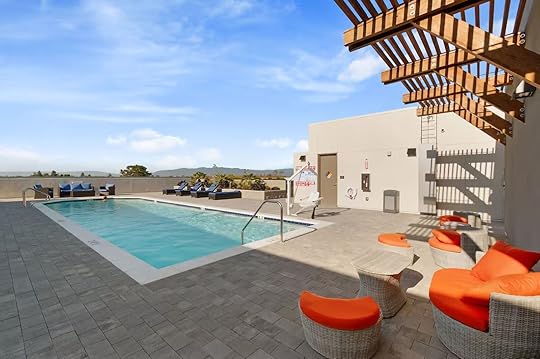 Photo: AirbnbSee more photos
Photo: AirbnbSee more photosDistance from Levi’s Stadium: 15-minute drive
Location: Santa Clara — a central base just a short drive to Levi’s Stadium, Santa Clara University, and San Jose Airport. Walk to restaurants, groceries, and coffee shopsWho is this Airbnb for? Couples looking for a quiet, modern space — with perks like a pool, smart TVs, and easy parkingCapacity: Two bedrooms, two bathrooms — king bed in the primary suite and a queen in the second bedroom, with a small convertible bed optionStandout amenities: Scenic community pool, kitchen with stainless steel appliances, in-unit laundry, central AC, smart TV in living room and primary bedroomWhat reviews say: A top-rated guest favorite — reviewers mention the spotless interior, smooth self check-in, and host communication that makes the stay seamless
Price: $233 per night
Book NowMore like thisTravelThe Best Hotels Near the Bay Area's Levi's Stadium for Soccer FansIs Delta Air Lines Using AI to Charge You More? What We Know So Far.

According to a surge of recent reports, Delta Air Lines has quietly rolled out a new pricing strategy bound to be controversial. Unlike dynamic pricing that changes flight fares based on factors like seat availability or what time and what day a flight is booked, the new technology adjusts the price by how much the airline thinks a user is personally willing to pay.
According to company leadership, Delta is now using AI to set proposed fares for passengers on an individual basis. It says the system is more efficient, but definitely more profitable, than older models. As of now, only about 3 percent of domestic fares are being sold using the new AI model, though Delta President Glen Hauenstein told investors earlier this month that the goal is to raise that to 20 percent by the end of the year.
It’s a change many consumer watchdog groups and even some lawmakers are calling discriminatory, invasive, and potentially predatory to consumers.

With both dynamic and AI-assisted pricing, two passengers in seats next to each other may have paid drastically different fares. Photo: DC Studio/Shutterstock
It’s well known that the aviation industry has used dynamic pricing for decades. In dynamic pricing models, fares can change throughout the day based on factors like time of booking, how much demand there is for the route, seat availability, and the day of the week. The systems are rule-based and somewhat predictable, loosely based on the idea that prices go up when demand increases and drop when fewer people are interested. The rate is generally the same for each person, provided they’re booking the same ticket at the same time.
Delta’s new AI model is a drastic change in that it’s personalized (or some might say “targeted”) to each potential flyer. Instead of calculating prices based on broad traveler trends, the AI estimates an individual’s willingness to pay in real time. That means that two buyers searching for the same flight at the same time could be offered totally different prices based on undisclosed information and factors an AI can surmise about that person. The technology is built by a company called Fetcherr, which says its system calculates individualized pricing based on millions of data points, including “factors like customer lifetime value, past purchase behaviors, and the real‑time context of each booking inquiry.”
In a statement to Business Insider, Delta denied it would use any personal information to influence pricing, including browsing history, financial data, or location data. However, as of now, Delta has declined to specify what data points the AI does use.
“The biggest shift is that AI pricing goes beyond the traditional supply-and-demand model and tailors prices to each individual in real time,” Jesse Neugarten, founder and CEO of Dollar Flight Club, tells Matador Network. He says that in the past, it was route-based factors that determined the cost. “With AI, the algorithm can ingest tons of personal signals like your browsing history, device type, even estimated income level and spit out a price just for you.”
Which could lead to higher prices for flyers overall.
“It’s no longer just ‘prices are going up because a flight is filling up,’” Neugarten says. “Now, it’s ‘prices are going up for you because we think you’ll still pay it.’”
AI pricing is already facing pushback from lawmakersView this post on InstagramA post shared by Ruben Gallego (@gallegoforaz)
Three Democratic senators (Ruben Gallego of Arizona, Richard Blumenthal of Connecticut, and Mark Warner of Virginia), already sent a warning to the airline, suggesting that AI pricing may be “surveillance-based pricing” — a practice considered predatory to consumers. The senators asked Delta to respond by August 4 with details about what data the AI uses, how the algorithm is trained, and how many passengers have been captured using AI pricing. What may come from the conversation remains to be seen, but it could result in a larger conversation (and potentially regulation) on how AI can be used for consumer pricing.
Consumer advocacy groups echoed the senators’ concerns. “They’re trying to see into people’s heads to figure out how much they’re willing to pay,” according to Justin Kloczko, a reporter with Consumer Watchdog. “It’s hacking our brains for maximum profit.”
In addition to the proposed unfairness of the model, another concern is that the AI pricing tool will create financial penalties for infrequent travelers in an attempt to reward more frequent fliers. That could translate to more expensive fares for lower-income travelers. Studies published in early 2025 across all industries (not just airlines) showed that lower income buyers tend to see the biggest increases in pricing under AI-driven pricing models.
“Legality depends on how the data is sourced and used, but there’s no clear law that says an airline can’t offer a different price to different people based on personal data,” Neugarten says. “Fairness is a different story. If two people are shown two prices for the same seat based solely on how much the system thinks they’re willing to pay, that erodes consumer trust fast. Most travelers have no idea this is happening behind the scenes, which is part of the problem.”
Conversely, Delta says the model is really nothing new. A Delta spokesperson told Boston 25 News that AI pricing technology is just another way of doing what it has been doing for years: changing airfare prices based on demand and availability, and using AI simply “streamlines” that process. And according to Delta President Hauenstein, it’s been profitable, telling investors on the same call that it’s resulting in “amazingly favorable unit revenues.” In other words, consumers are paying more, and the airline is making more money.
Neugarten says while it is technically just an extension of what Delta has already been doing, it’s a big one. “This is the first time we’re seeing personalized pricing on this level, and at machine speed.” He thinks it’s a major shift, akin to flight prices becoming more like an online auction than a clear transaction. “Travelers who aren’t aware of this trend risk overpaying without even realizing it,” he adds.
How to beat the algorithm (maybe)
Photo: Funstock/Shutterstock
Because Delta’s AI pricing model is opaque, with the airline intentionally not sharing what factors determine a price, there’s no foolproof way for travelers to avoid AI pricing. But based on what’s known about similar systems, there are a few educated guesses you can make based on what may be an influencing factor. None of these are guaranteed to work, but in general, taking steps to protect your privacy online isn’t a bad idea anyway.
Shop in incognito mode: AI-powered pricing tools probably don’t use cookies, but using a standard browser may give away information like repeat search behavior, or what website you were just on. Using incognito mode, or switching between unlinked devices for different searches, may help minimize how much data Delta can see.
Delay or rush your airfare purchase: Some AI models consider urgency as a factor. So if you’re repeatedly checking the cost of a route over and over, or searching for a very last-minute ticket, the system may think you’re desperate, and try to charge you more. Booking early could help. However, booking a seat at the very last minute could work, too, as the model may lower the price if it thinks you’re undecided on traveling.
Use a VPN to hide your location: Delta says it doesn’t use geolocation for AI pricing, but the broader travel industry often does. Changing your virtual location with a VPN may yield different fares, particularly on international routes. It may also stop programs from being able to make assumptions about your income or ability to pay based on your residential zip code.
Clear your cache and history: Again, Delta says it doesn’t use personal browsing behavior. But just in case other sites do, clearing your saved information and browsing history can reduce the risk of AI systems being able to recognize patterns it can use to adjust the price.
Use a different device than your daily phone or computer: “Booking on a lower-end Android phone may get a different result than a MacBook Pro,” Neugarten says Neugarten.
Change your profile or loyalty status: AI pricing models may reward frequent travelers. However, there’s also a chance it could interpret loyalty status as a sign that you’re willing to pay more to fly with a certain airline. Searching while logged out, as a guest, or on a brand new profile could help you avoid being classified as potential higher paying customer. 
Rivian Opens New Outpost EV Charging Center and Hub in Hamptons

The future of fueling up on the road will look much different than today’s gas stations. But what, exactly, will change? Electric vehicle maker Rivian debuted its take on the in-trip charging stops through its debut EV charging center in Groveland, California, just west of Yosemite National Park and near many of the park’s closest accommodations. That Rivian Outpost opened in 2024, followed by a second Outpost in Joshua Tree in December of that year. Now, Rivian is opening its third location in the Hamptons just in time for the height of summer travel.
Located on the Montauk Highway in Southampton, the third Rivian Outpost opens August 7 and channels the mellow coastal vibes of the area. It’s located in a cedar shingle building that is as much of a rest stop as it is a charging center. To celebrate the opening, charging will be free August 7 through August 10. Like other Rivian Outpost locations, this one will offer a lounge area and snacks in a far more inspiring setting than that of the traditional hurried convenience store. Don’t have a Rivian? You can book a test drive in a Rivian R1S or R1T during the opening celebrations as well through the company’s Demo Dive page.
What to know about Rivian Outpost charging centers Rendering courtesy Rivian
Rendering courtesy Rivian Photo courtesy Rivian
Photo courtesy RivianGiven the nature of electric vehicles taking longer to top off than those with internal combustion engines, travelers will need a place to spend half an hour or so rather than just a few minutes. The Outpost locations operate as both a charging center and a community hub. Customers can learn about EV charging and road trip basics, enjoy coffee and other food and beverage options more akin to a simple cafe than a typical convenience store, and spend time planning their trip while their car juices up.

Rendering of the interior of the Rivian Outpost at Yosemite. Courtesy Rivian
For the inaugural Yosemite Outpost project, Rivian repurposed an existing building that throughout its history had served as a blacksmith shop, a repair shop, and a gas station, retrofitting it for a future assisting travelers and outdoor adventurers en route.
Drivers of all types of electric vehicles, not just Rivians, will be able to enjoy the amenities, though the Rivian Adventure Network of DC fast chargers has gradually started to open many of its stations to all NACS-compatible EVs with the appropriate adapter. As of May 2025, about 42 percent of Rivian Adventure Network locations are now available for non-Rivian vehicles, and this number is growing. The remaining stations are still exclusive to Rivian owners, but the company’s stated plan is to continue expanding public access to more locations over time. The company plans to open the network to drivers of other electric vehicles later this year. Rivian owners don’t even need to touch a button to charge at Outpost or any of the forthcoming 3,500+ chargers in the network, which will be installed in the coming years at approximately 600 initial sites along popular routes and highways. Rivian drivers can add up to 140 miles of range in 20 minutes, according to the company.

Photo Sara Essex Bradley, courtesy Rivian
Outpost locations aim to produce zero emissions in daily operations, the Yosemite location accomplishing this thanks to a donation from US Solar. The building will be outfitted with enough solar power to cover what it uses, which, given its primary purpose as a place for drivers to charge their cars, is set to be a lot. Snacks look to be available in bulk, avoiding the use of single-use plastic bags as much as possible. Travelers will also have the opportunity to stock up on simple adventure basics and souvenirs – think t-shirts and reusable water bottles.
Rivian releases travel kitchen powered by its trucksAlso in 2024, Rivian announced the release of a travel kitchen that drivers can bring with them on their adventures. The two-burner stovetop can be powered by the truck itself, or by an auxiliary 120v power source, and comes with a small prep area that includes a cutting board. The cookstove is sized to be placed on the back gate of the truck, but is portable and can be used anywhere where power can reach it.
The travel kitchen includes a pull-out drawer for utensils with an add-on accessories kit including spatulas, kinves, silverware, and more available for $200. Rivian partnered with Snow Peak for the kitchen utensils, with other options like a kive and cutting board set and barbecue tongs, and coffee drips also for sale. The kitchen unit itself costs $1,400 and can be ordered online. 
July 21, 2025
I Was the Original Horse Girl. This Luxury Lodge in Wyoming Delivered My Grown-Up Western Fantasy.

My dad gave me my first pair of jodhpur riding pants when I was seven. While my friends were heading to the mall on weekends, I was mucking stalls and memorizing every inch of my horse Rocket’s blaze, the wide white stripe running from his forehead to his muzzle.
I didn’t just like horses — I was the horse girl, in all the obsessive, horse-folder, saddle-sore glory that entails. Though I’ve grown up, swapped my paddock boots for Marc Fisher heels, and now write about travel for a living, that part of me never left.
Decades later, I found myself chasing that same freedom — this time in Jackson Hole, Wyoming, where The Sylvan Lodge, tucked inside the Snake River Sporting Club, offers a new kind of Western escape: one that smells like pine and saddle leather in the morning, but also like fresh espresso and orange blossoms from a post-spa facial.
It’s the kind of place that reminds you that the Wild West doesn’t have to be wild all the time. Sometimes, it can be a little bit soft — like the whistling wind through the aspens. Sometimes, it can be downright indulgent — like the welcoming bottle of Wyoming whiskey in my suite.
The West, reimagined
Photos: The Sylvan Lodge
The moment I arrived at The Sylvan Lodge, I felt something familiar stir — like the West I’d always dreamed of as a kid, only real, grounded, and wrapped in the soft edges of grown-up comfort.
The lodge hums with luxury. Every space tells a story. The River Room, where I lingered over omelet breakfasts and whatever the immaculate baker whipped up that morning, is bathed in a shimmer designed to mimic the way sunlight dances on the Snake River. Rooms are trimmed in European white oak, and beds are dressed with Frate sheets and Italian duvets so soft they practically exhale. It was the fluffy robe and slippers that did it for me. After a long day of travel, they were exactly what I needed.
That first afternoon, our group was guided through the property by Director of Lodging Michael Gray, whose tour felt more like a gentle reveal: the spa that smells like eucalyptus and quiet mornings, the tucked-away infinity pool overlooking Snake River Canyon, and small but thoughtful touches like extra wooden locker rooms specifically for ski boots and muddy manure boots. The details mattered all around, down to the tissue box covers and the bath bombs in the spa-bath suites. The Sylvan Lodge doesn’t try to be all things; it is all things. Every need is anticipated before it’s even noticed.
Even before I slipped into a robe for my Citrus Essence facial, I knew this wasn’t just a lodge — it was a retreat in the truest sense.
Lodge life, rugged and refined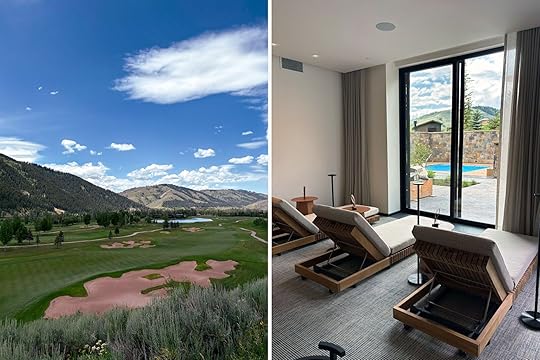
Photos: Tess St. John
What surprised me most was how seamlessly the experiences flowed. One moment, I was casting a rod into the Snake River, watching bald eagles trace lazy circles above the canyon. The next, I was sipping Caymus wine and roasting s’mores at the Dark Sky Bar under a twinkling sky, fresh off a private chef’s dinner in the penthouse suite — where, yes, there’s a rooftop hot tub all to yourself, overlooking the river and the surrounding mountains.
Then, there was the golf. Even as someone who rarely swings a club and has yet to hit a par (one chip away every time), I was floored by the course’s setting. Designed by Tom Weiskopf, the 7,500-yard marvel, ranked the number-two golf course in Wyoming, winds along the Snake River and through cottonwood groves with the mountains as its backdrop. Playing there felt less like a round of golf and more like a reverent walk through the wilderness. Whether you’re chasing your handicap or just admiring the scenery, it’s the kind of place where the land feels as intentional as the swing.
Later that evening, we traded golf carts for binoculars and set off on a sunset wildlife drive through Grand Teton National Park — a slow, golden-hour immersion into one of the most awe-inspiring landscapes in the country. Guided by local naturalist Jason, we wound alongside marshes in search of moose hiding in the brush, pausing to check if the rustle in the tall grass was a grizzly peeking out for a look. The highlight? Amid an open plain of grazing bison, there — on the distant horizon — was a wolf devouring a calf. It was Planet Earth in real life. Awestruck, we crept closer for a better look at this marvel of nature. We didn’t spot a grizzly, but I’d say my wildlife search was more than successful.
With every turn, the Tetons loomed larger — jagged and glowing, like the closing scene of a John Wayne classic, the kind where the hero rides off toward a horizon that never quite ends. It wasn’t just a tour; it was a glimpse into the wildness that pulses at the edge of luxury.
Wellness, wild styleI’ve been on a few “outdoorsy” press trips, but rarely one where I ended the day as relaxed as I started it. The spa at The Sylvan Lodge felt entirely in tune with the environment. My facial wasn’t just rejuvenating — it was restorative, using Natura Bissé products and local botanicals to bring me back to center after a day outdoors.
For those who like to balance the rugged with the restorative, the lodge’s wellness amenities are next-level: a fitness center with private yoga and Pilates; a steam room, cold plunge, sauna, red light therapy room; and a dedicated exercise pool and hot tub relaxation lounge — each space mirroring the quiet elegance found throughout the property.
Everything here — meals, moments, and massages — felt like it belonged exactly where it was.
Trail dreams, rewritten
Photos: Tess St. John
Of course, I was here for the horses, too. The wine and cheese trail ride was everything my childhood self could’ve dreamed up — only better dressed. We saddled up at the ranch in the late afternoon, sunlight slicing through the cottonwoods. My horse, Bud, moved with the kind of rhythmic confidence that only seasoned trail companions have, and as we followed the Snake River’s edge, it felt like riding through the pages of a story I already knew by heart.
Halfway through, we dismounted for a charcuterie spread of local meats, cheeses, and wine, all elegantly laid out beneath the trees. Sebastian, the lodge’s sommelier, poured a crisp glass of pinot grigio that shimmered like melted butter in the glass — and tasted just as luxurious. We sat beneath a canvas tent set just for us, shaded and secluded, while the horses grazed peacefully just feet away. It was the kind of moment that felt suspended in time — equal parts nostalgia and total novelty.
The Sylvan Lodge, maximized
Photos: Tess St. John
You don’t need to be a horse girl to love The Sylvan Lodge. You just need to crave space: to breathe, to move slowly, and to watch clouds gather over the mountains. You might hike, ride, golf, go skeet shooting or fly-fishing, try archery, or simply read by the infinity pool overlooking the Snake River Canyon, drink in hand, and sagebrush rustling in the breeze.
This is a place for people who want the feel of a remote escape without giving up a well-made cappuccino or a feather-soft bed. It’s for adventurers who like a little elegance, and dreamers who believe the West can still surprise them.
While this positions the lodge as a sort of choose-your-own-adventure experience, there are, in my opinion, a few must-dos while you’re on the property: the wine and cheese trail ride, any of the spa treatments, a scenic float, a wildlife drive, a round of golf, and fly-fishing on the Snake River. Be sure to pack layers when you visit, as well as a wide-brimmed hat (with a tie), closed-toe shoes for horseback riding, and a swimsuit for the pool and cold plunge. Plan to come during summer or early fall — unless you’re a winter-sport traveler, in which case The Sylvan Lodge is your year-round playground.
What it was for me is a place that gave me everything I never knew I needed: the nostalgia of my horse girl days, the serenity of the mountains, and the kind of thoughtful, place-rooted luxury that makes you want to slow down and stay forever.
Rocket would’ve loved it here. 
Where to Play, Eat, and Stay in Walton County, Florida
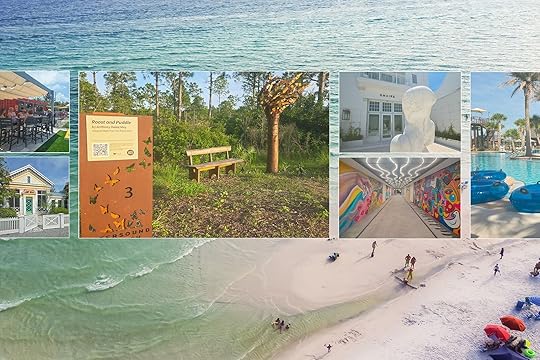
Walton County is a stretch of Florida’s Emerald Coast between Pensacola and Destin, full of Southern eateries, businesses focused on sustaining the environment, and an unabashed love of local artists and artisans. The more affluent and recently renovated part of Walton County, it’s characterized by eco-friendly businesses, walkable neighborhoods, and mid-range to upscale offerings. For generations, Walton County has been a road-trip vacation destination, thanks in part to Scenic Highway 30A. Living up to its name, the highway connects more than 20 miles of coastline along Florida’s panhandle.
South Walton includes the towns of Grayton Beach, Alys Beach, Rosemary Beach, Seaside, Seagrove, and WaterColor. In some instances — like White Lotus-esque Kaiya Beach Resort or film-set-like planned communities like the all-white Alys Beach — it can feel a bit unsettling to see so much rigidly pristine perfection. But at its best, South Walton represents what it can look like when eco-centric tourism prioritizes local people, the need for the local arts, and the local environment. The area has adopted Highway 30A not only as local branding but as a way of life. With a slower speed limit than nearby US Highway 98, 30A has come to symbolize taking things slow to enjoy the beautiful ocean views, the area’s focus on ecological conservation, and a love of all things local.
Things to do in South WaltonBike the Watersound® Monarch Art Trail
Photos: Delia Harrington
Enjoy nature, art, and the slower pace of life on the Watersound® Monarch Art Trail (MAT). A mile-long walking and biking path between Highways 30A and 98, the MAT features eight sculptures (complete with QR codes with information about each sculpture and the local environment), as well as benches where you can sit to listen to the self-guided audio tour while enjoying the view. See if you can spot the butterfly inspiration on each one.
Northwest Florida is part of the monarch butterfly’s migration pattern each year, and South Walton is no exception. The MAT brings together art and ecology, with the sculptures and native plants along the edge of the nature preserve making resting perches for the butterflies. The Cultural Arts Alliance, in partnership with The St. Joe Community Foundation, created the MAT as part of its Art in Public Spaces Program. Take your ride at either end of the day to beat the heat — sunset makes for an especially beautiful ride.
Watersound® Monarch Art Trail: S Watersound Pkwy, Panama City Beach, FL 32413
Browse the artworks at OMAIRE Gallery
Photos: Delia Harrington
OMAIRE is South Walton’s first fine art gallery. Located within Kaiya Beach Resort, the gallery is free and open to the public. The gallery’s debut exhibit is The Divine Feminine by sculptor Claire McArdle, curated by Terry D. Slaughter. Gorgeous marble pieces blend the figurative and the abstract, from small figurines and busts to life-size standing and reclining statues. A mix of smooth, feminine curves and an intentionally weathered, textured look, the collection calls to mind artifacts found among ancient ruins, like so many time-worn treasures pulled from the Aegean Sea.
Several of the pieces were acquired by The Kaiya Foundation, the resort’s nonprofit arm, for the purpose of becoming permanent fixtures in the resort. The Kaiya Foundation is also working with OMAIRE on a number of local initiatives to give back, including sponsoring an art-focused summer camp for students in need. Gallery hours are Tuesday through Sunday from 10 AM to 7 PM or by appointment. The Divine Feminine will be on view until September 6, 2025.
OMAIRE: 25 Kaiya Ave, Suite 2, Inlet Beach, FL 32461
Make a clay mug at the Bayou Arts Center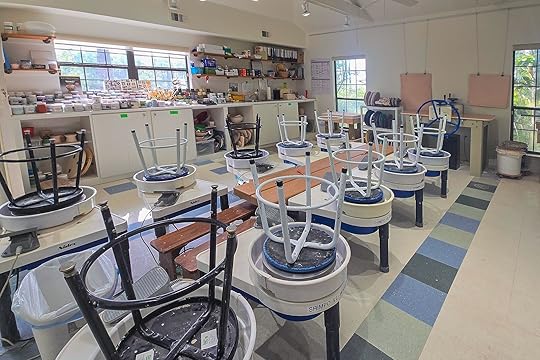
Photo: Delia Harrington
You can feel the presence of the nonprofit Cultural Arts Alliance throughout South Walton, but if you really want to flex your creative muscles, head to the picturesque Bayou Arts Center to take a class. Don’t worry if you’re not particularly artistically inclined, or if you’ve never thrown clay before. Lead instructor Jessica Batson is great with newbies and takes a thoroughly unpretentious “there’s no wrong way to make art” approach to her classes. The center also does its best to recycle any clay scraps, and you can even take home unclaimed (“orphaned”) pottery projects by making a pay-what-you-want donation.
By supporting the center, you’re helping to support many excellent local initiatives, like its local arts advocacy work, prison art program, therapeutic arts program, artist grants and scholarships, periodic fundraisers for causes like breast cancer, and the marine conservation initiative known as the Underwater Museum of Art. The Cultural Arts Alliance also organizes all sorts of workshops, so if a mug isn’t your speed (or won’t fit in your suitcase), check out its full slate of offerings.
Cultural Arts Alliance: 105 Hogtown Bayou Ln, Santa Rosa Beach, FL 32459
Shop, play, and dine at Cowgirl Kitchen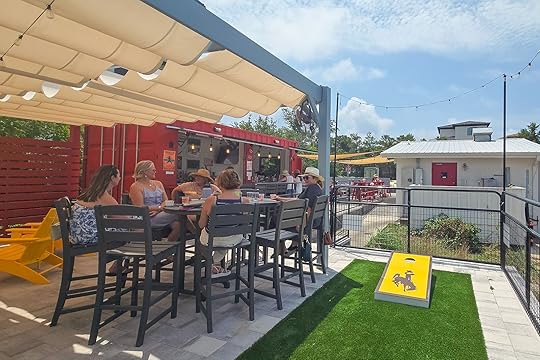
Photo: Delia Harrington
Cowgirl Kitchen is a woman- and queer-owned business with one very charismatic owner and three locations in South Walton. For the best bang for your buck, go to the market and cafe in Blue Mountain Beach to shop, play some cornhole, and enjoy all-day mimosas (perhaps with some cheese grits and praline bacon that I can’t recommend enough).
The market promotes local, Florida-based, and regional women artists, including 30A merch, trendy upcycled accessories, decorative and functional pottery, original art and prints, and Americana apparel with a sassy spin. You can also catch an event like live music, Cowgirl Flow Yoga, Young Bucks Soiree (young professionals night), and watch parties for local sports.
You can also hit up the other two locations — Cowgirl Kitchen Rosemary Beach and CK’s Feed & Supply Rosemary Beach (right behind the restaurant) — for wine, cheese, dips, and other to-go picnic provisions to cowgirl up your beach hang.
Cowgirl Kitchen: 2252 W County Hwy 30A, Blue Mountain Beach, FL 32459
Admire the murals at the Inlet Beach Underpass
Photo: Delia Harrington
Check out some local art at the Inlet Beach Underpass. A pedestrian and cyclist tunnel, it makes the area safer and easier for cyclists, pedestrians and drivers alike, while turning what would otherwise be a boring cement feature into a cool spot to highlight local artists. Ten local artists painted 20-foot-wide murals in distinct styles in the lit tunnel. The underpass is wheelchair accessible, and also features a replica sculpture on each end from the Underwater Museum of Art, a rare chance to glimpse that art without needing SCUBA gear!
Inlet Beach Underpass: Intersection of US Highway 98 and Scenic Highway 30A, Inlet Beach, FL 32413
See The Truman Show town in real life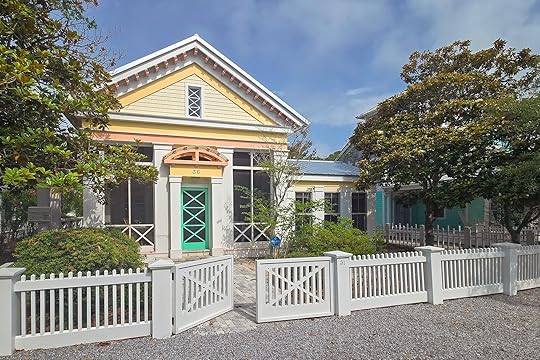
Photo: Delia Harrington
It’s not hard to believe that 1998’s The Truman Show, starring Jim Carrey, was filmed in Seaside. What’s more surprising is that they didn’t have to change the town to look like the cookie-cutter fictional town of Seahaven: it was selected because it already looked that way. One of several planned communities in the area, Seaside plays host to multiple filming locations from The Truman Show, including his home, the town gazebo, and the post office.
Seaside: Seaside, FL 32459
Where to eat and drink in South WaltonBud & Alley’sVer esta publicación en InstagramUna publicación compartida por Bud & Alley's (@budandalleys)
Founded in 1987 by a couple of surfers and named for the owner’s dog and the town founder’s cat, Bud & Alley’s is the definition of local and holds the record as Walton County’s oldest restaurant. Its menu spans from pizza and tacos to upscale Gulf Coast seafood, reflecting the vibe as well as the clientele. You’re just as likely to see someone come up from the boardwalk in a bathing suit as a couple out for a swanky night (they even do weddings). The frozen peach Bellini is a great way to enjoy a seat on the breezy deck with a view of the water — if you’re lucky enough to grab a spot (the deck is first-come, first-served). Bud & Alley’s serves local catch, and the peel and eat shrimp and crab cakes are especially good.
Bud & Alley’s: 2236 E County Hwy 30A, Seaside, FL 32459
Idyll Hound ProperView this post on InstagramA post shared by Idyll Hound Proper (@idyllhoundproper)
Enjoy local brews from Idyll Hounds Brewing Company, elevated cocktails, and an Asian-fusion twist on Southern classics outside on the patio or in the eclectic dining room at Idyll Hound Proper. Waitstaff steered us toward anything Asian-influenced on the menu since it’s Head Chef Nick Walton’s specialty, and they were right. Some temporary specials were so beloved, they’ve become permanent menu fixtures, like the delicious Bangin’ Grouper.
Idyll Hound Proper: 12805 US-98 E101, Inlet Beach, FL 32461
Amavida in Rosemary BeachView this post on InstagramA post shared by Amavida Coffee Roasters (@amavidacoffee)
There are plenty of cute places to pick up a coffee or a quick breakfast in South Walton, but Amavida is a local favorite for a reason. The fair-trade roaster is committed to uplifting both the farmers who harvest its coffee beans and the local community in Rosemary Beach. Owned by a local husband and wife team, Amavida has local art on the walls and pays dignifying wages to farmers. Its breakfast burritos are the way to go, but you certainly won’t be disappointed by the pastry case, either. Amavida also has a location in Seaside.
Amavida: 104 North Barrett Square Unit 1A Lofts West, Rosemary Beach, FL 32461
Havana Beach Bar & GrillView this post on InstagramA post shared by Havana Beach Bar and Grill (@havanabeachbarandgrill)
Inspired by Ernest Hemingway’s beloved El Floridita in Havana (“My mojito in the Bodeguita del Medio and my daiquiri in the Floridita”), Havana Beach’s cocktail menu is formidable (and, of course, includes a daiquiri). Come for dinner and enjoy live piano music while you sip on a drink or an authentic glass of Havana Club rum. The restaurant is located inside The Pearl Hotel, in the planned community of Rosemary Beach.
The menu is more upscale Floridian than anything you’ll find in Havana — no arroz moro (Cuban rice and beans) here, and the only ropa vieja (shredded stewed beef) is in a breakfast hash — but don’t let that stop you. The grouper bites are a must, and the crab cakes are solid. Keep your eye out for great art throughout the restaurant, including a piece by Claire McArdle, whose work is currently on view at OMAIRE at Kaiya Beach Resort. Be sure to check out the Havana Beach Rooftop before you go — which also serves a slimmed-down food and drink menu — for fantastic views of Rosemary Beach.
Havana Beach Bar & Grill: 63 Main St, Rosemary Beach, FL 32413
Where to stay in South WaltonCamp Creek Inn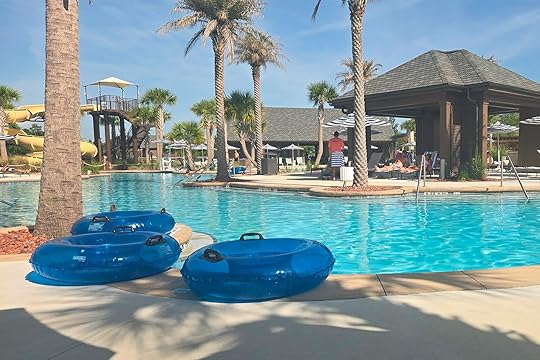
Photo: Delia Harrington
Boutique hotel Camp Creek Inn is located on Highway 30A in Inlet Beach. Service is a high point here — I don’t think I opened a single door myself during my stay, and housekeeping came multiple times a day, even coiling my charging cables. There’s a huge water slide at the resort-style pool, a lazy river, and an adults-only pool if you’re not feeling the kid vibe. The hotel also has pickleball courts and lessons for everyone from beginners to experts, as well as facilities for golf, tennis, fitness, and wellness, plus bikes to borrow.
Be sure to check out ANR, Camp Creek Inn’s high-end restaurant with an elevated take on Gulf Coast favorites. The crab cake is a clear standout — and a hearty portion to boot. The indoor cocktail bar and outdoor patio fire pits (with waitstaff serving the full bar menu, including food) are a huge plus. Also, check out the Treat Suite on each floor — turning the concept of the overpriced mini-bar on its head, the Treat Suite offers 24/7 access to all manner of snacks (including chips, cookies, granola bars, ice cream sandwiches, juice, soda, coffee, tea, and hot cocoa) all included with the price of your room.
Camp Creek Inn: 684 Fazio Dr, Inlet Beach, FL 32461
Kaiya Beach Resort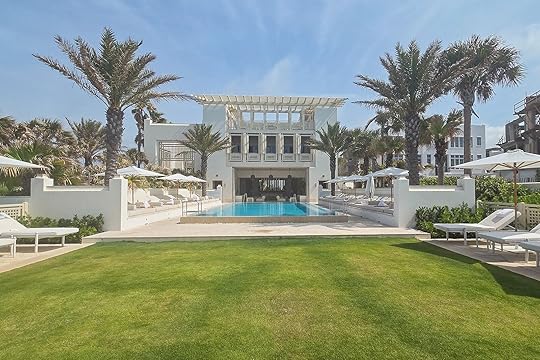
Photo: Delia Harrington
This pristine, gated wellness resort and community is focused on calm, quiet rejuvenation. Whether you invest in a multi-million dollar condo or row house or choose to stay at one of the $2,000+//night villas in the resort, Kaiya delivers peace, stillness, and luxe details. Check out the on-site yoga classes or OMAIRE, the in-house fine art gallery, to find your center and deepen a sense of contemplation during your stay. Enjoy the infinity pool or beachside chaises on the private, pristine white sand of Inlet Beach at Kaiya Beach House.
Plan to have at least one meal at Kaiya Beach House to enjoy food from Chef Phillip McDonald of Black Bear Bread Co. There’s no heavy fried food here — the focus is on fresh, seasonal, local farm-to-table meals. The food is so good that even dressed garbanzo beans and sweet potatoes feel indulgent — and you won’t even notice that you’re not eating meat. The flaky croissants are a can’t-miss.
Kaiya Beach Resort: 25 Kaiya Ave, Inlet Beach, FL 32461
Getting to and around South Walton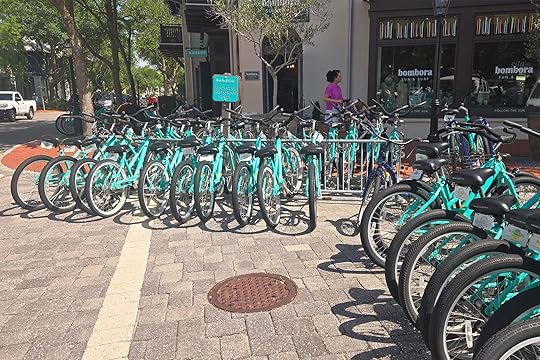
Photo: Delia Harrington
Northwest Florida Beaches International Airport (ECP) in Panama City, Florida, opened in 2010, only about 40 minutes away from Inlet Beach, making Walton County an easy flight from cities like Atlanta, Baltimore, Chicago, Austin, Dallas, Houston, Nashville, and St. Louis. Previously, it was more of a driving destination from surrounding states. You can also fly into Destin-Fort Walton Beach Airport (VPS), which is just over an hour from Inlet Beach, or the larger Pensacola International Airport (PNS), which is a little over two hours from Inlet Beach or 1.5 hours from Destin — but the convenience of a small (dare I say) friendly airport like ECP is unmatched.
One of the biggest draws of South Walton is how walkable each neighborhood is. You’ll need a way to get between them, but there are plenty of rideshares and cabs available if you’re not interested in renting a car. Biking is also a major way of life in South Walton, with plenty of bike rental companies available. (Some resorts and Airbnbs also make bikes available to guests.) The terrain is flat, and there are some great bike paths, so you’ll see a lot of people without helmets and a lot of cruiser bikes on offer, with no brakes or gears. Make sure you get one with a basket to carry your water, sunscreen, and towel. 
Where to Play, Eat, and Stay in South Walton County, Florida

South Walton County is a stretch of Florida’s Emerald Coast between Pensacola and Destin, full of Southern eateries, businesses focused on sustaining the environment, and an unabashed love of local artists and artisans. The more affluent and recently renovated part of Walton County, it’s characterized by eco-friendly businesses, walkable neighborhoods, and mid-range to upscale offerings. For generations, South Walton County has been a road-trip vacation destination, thanks in part to Scenic Highway 30A. Living up to its name, the highway connects more than 20 miles of coastline along Florida’s panhandle.
South Walton County includes the towns of Grayton Beach, Alys Beach, Rosemary Beach, Seaside, Seagrove, and WaterColor. In some instances — like White Lotus-esque Kaiya Beach Resort or film-set-like planned communities like the all-white Alys Beach — it can feel a bit unsettling to see so much rigidly pristine perfection. But at its best, South Walton County represents what it can look like when eco-centric tourism prioritizes local people, the need for the local arts, and the local environment. The area has adopted Highway 30A not only as local branding but as a way of life. With a slower speed limit than nearby US Highway 98, 30A has come to symbolize taking things slow to enjoy the beautiful ocean views, the area’s focus on ecological conservation, and a love of all things local.
Things to do in South Walton CountyBike the Watersound® Monarch Art Trail
Photos: Delia Harrington
Enjoy nature, art, and the slower pace of life on the Watersound® Monarch Art Trail (MAT). A mile-long walking and biking path between Highways 30A and 98, the MAT features eight sculptures (complete with QR codes with information about each sculpture and the local environment), as well as benches where you can sit to listen to the self-guided audio tour while enjoying the view. See if you can spot the butterfly inspiration on each one.
Northwest Florida is part of the monarch butterfly’s migration pattern each year, and South Walton County is no exception. The MAT brings together art and ecology, with the sculptures and native plants along the edge of the nature preserve making resting perches for the butterflies. The Cultural Arts Alliance, in partnership with The St. Joe Community Foundation, created the MAT as part of its Art in Public Spaces Program. Take your ride at either end of the day to beat the heat — sunset makes for an especially beautiful ride.
Watersound® Monarch Art Trail: S Watersound Pkwy, Panama City Beach, FL 32413
Browse the artworks at OMAIRE Gallery
Photos: Delia Harrington
OMAIRE is South Walton County’s first fine art gallery. Located within Kaiya Beach Resort, the gallery is free and open to the public. The gallery’s debut exhibit is The Divine Feminine by sculptor Claire McArdle, curated by Terry D. Slaughter. Gorgeous marble pieces blend the figurative and the abstract, from small figurines and busts to life-size standing and reclining statues. A mix of smooth, feminine curves and an intentionally weathered, textured look, the collection calls to mind artifacts found among ancient ruins, like so many time-worn treasures pulled from the Aegean Sea.
Several of the pieces were acquired by The Kaiya Foundation, the resort’s nonprofit arm, for the purpose of becoming permanent fixtures in the resort. The Kaiya Foundation is also working with OMAIRE on a number of local initiatives to give back, including sponsoring an art-focused summer camp for students in need. Gallery hours are Tuesday through Sunday from 10 AM to 7 PM or by appointment. The Divine Feminine will be on view until September 6, 2025.
OMAIRE: 25 Kaiya Ave, Suite 2, Inlet Beach, FL 32461
Make a clay mug at the Bayou Arts Center
Photo: Delia Harrington
You can feel the presence of the nonprofit Cultural Arts Alliance throughout South Walton County, but if you really want to flex your creative muscles, head to the picturesque Bayou Arts Center to take a class. Don’t worry if you’re not particularly artistically inclined, or if you’ve never thrown clay before. Lead instructor Jessica Batson is great with newbies and takes a thoroughly unpretentious “there’s no wrong way to make art” approach to her classes. The center also does its best to recycle any clay scraps, and you can even take home unclaimed (“orphaned”) pottery projects by making a pay-what-you-want donation.
By supporting the center, you’re helping to support many excellent local initiatives, like its local arts advocacy work, prison art program, therapeutic arts program, artist grants and scholarships, periodic fundraisers for causes like breast cancer, and the marine conservation initiative known as the Underwater Museum of Art. The Cultural Arts Alliance also organizes all sorts of workshops, so if a mug isn’t your speed (or won’t fit in your suitcase), check out its full slate of offerings.
Cultural Arts Alliance: 105 Hogtown Bayou Ln, Santa Rosa Beach, FL 32459
Shop, play, and dine at Cowgirl Kitchen
Photo: Delia Harrington
Cowgirl Kitchen is a woman- and queer-owned business with one very charismatic owner and three locations in South Walton County. For the best bang for your buck, go to the market and cafe in Blue Mountain Beach to shop, play some cornhole, and enjoy all-day mimosas (perhaps with some cheese grits and praline bacon that I can’t recommend enough).
The market promotes local, Florida-based, and regional women artists, including 30A merch, trendy upcycled accessories, decorative and functional pottery, original art and prints, and Americana apparel with a sassy spin. You can also catch an event like live music, Cowgirl Flow Yoga, Young Bucks Soiree (young professionals night), and watch parties for local sports.
You can also hit up the other two locations — Cowgirl Kitchen Rosemary Beach and CK’s Feed & Supply Rosemary Beach (right behind the restaurant) — for wine, cheese, dips, and other to-go picnic provisions to cowgirl up your beach hang.
Cowgirl Kitchen: 2252 W County Hwy 30A, Blue Mountain Beach, FL 32459
Admire the murals at the Inlet Beach Underpass
Photo: Delia Harrington
Check out some local art at the Inlet Beach Underpass. A pedestrian and cyclist tunnel, it makes the area safer and easier for cyclists, pedestrians and drivers alike, while turning what would otherwise be a boring cement feature into a cool spot to highlight local artists. Ten local artists painted 20-foot-wide murals in distinct styles in the lit tunnel. The underpass is wheelchair accessible, and also features a replica sculpture on each end from the Underwater Museum of Art, a rare chance to glimpse that art without needing SCUBA gear!
Inlet Beach Underpass: Intersection of US Highway 98 and Scenic Highway 30A, Inlet Beach, FL 32413
See The Truman Show town in real life
Photo: Delia Harrington
It’s not hard to believe that 1998’s The Truman Show, starring Jim Carrey, was filmed in Seaside. What’s more surprising is that they didn’t have to change the town to look like the cookie-cutter fictional town of Seahaven: it was selected because it already looked that way. One of several planned communities in the area, Seaside plays host to multiple filming locations from The Truman Show, including his home, the town gazebo, and the post office.
Seaside: Seaside, FL 32459
Where to eat and drink in South Walton CountyBud & Alley’sVer esta publicación en InstagramUna publicación compartida por Bud & Alley's (@budandalleys)
Founded in 1987 by a couple of surfers and named for the owner’s dog and the town founder’s cat, Bud & Alley’s is the definition of local and holds the record as Walton County’s oldest restaurant. Its menu spans from pizza and tacos to upscale Gulf Coast seafood, reflecting the vibe as well as the clientele. You’re just as likely to see someone come up from the boardwalk in a bathing suit as a couple out for a swanky night (they even do weddings). The frozen peach Bellini is a great way to enjoy a seat on the breezy deck with a view of the water — if you’re lucky enough to grab a spot (the deck is first-come, first-served). Bud & Alley’s serves local catch, and the peel and eat shrimp and crab cakes are especially good.
Bud & Alley’s: 2236 E County Hwy 30A, Seaside, FL 32459
Idyll Hound ProperView this post on InstagramA post shared by Idyll Hound Proper (@idyllhoundproper)
Enjoy local brews from Idyll Hounds Brewing Company, elevated cocktails, and an Asian-fusion twist on Southern classics outside on the patio or in the eclectic dining room at Idyll Hound Proper. Waitstaff steered us toward anything Asian-influenced on the menu since it’s Head Chef Nick Walton’s specialty, and they were right. Some temporary specials were so beloved, they’ve become permanent menu fixtures, like the delicious Bangin’ Grouper.
Idyll Hound Proper: 12805 US-98 E101, Inlet Beach, FL 32461
Amavida in Rosemary BeachView this post on InstagramA post shared by Amavida Coffee Roasters (@amavidacoffee)
There are plenty of cute places to pick up a coffee or a quick breakfast in South Walton County, but Amavida is a local favorite for a reason. The fair-trade roaster is committed to uplifting both the farmers who harvest its coffee beans and the local community in Rosemary Beach. Owned by a local husband and wife team, Amavida has local art on the walls and pays dignifying wages to farmers. Its breakfast burritos are the way to go, but you certainly won’t be disappointed by the pastry case, either. Amavida also has a location in Seaside.
Amavida: 104 North Barrett Square Unit 1A Lofts West, Rosemary Beach, FL 32461
Havana Beach Bar & GrillView this post on InstagramA post shared by Havana Beach Bar and Grill (@havanabeachbarandgrill)
Inspired by Ernest Hemingway’s beloved El Floridita in Havana (“My mojito in the Bodeguita del Medio and my daiquiri in the Floridita”), Havana Beach’s cocktail menu is formidable (and, of course, includes a daiquiri). Come for dinner and enjoy live piano music while you sip on a drink or an authentic glass of Havana Club rum. The restaurant is located inside The Pearl Hotel, in the planned community of Rosemary Beach.
The menu is more upscale Floridian than anything you’ll find in Havana — no arroz moro (Cuban rice and beans) here, and the only ropa vieja (shredded stewed beef) is in a breakfast hash — but don’t let that stop you. The grouper bites are a must, and the crab cakes are solid. Keep your eye out for great art throughout the restaurant, including a piece by Claire McArdle, whose work is currently on view at OMAIRE at Kaiya Beach Resort. Be sure to check out the Havana Beach Rooftop before you go — which also serves a slimmed-down food and drink menu — for fantastic views of Rosemary Beach.
Havana Beach Bar & Grill: 63 Main St, Rosemary Beach, FL 32413
Where to stay in South Walton CountyCamp Creek Inn
Photo: Delia Harrington
Boutique hotel Camp Creek Inn is located on Highway 30A in Inlet Beach. Service is a high point here — I don’t think I opened a single door myself during my stay, and housekeeping came multiple times a day, even coiling my charging cables. There’s a huge water slide at the resort-style pool, a lazy river, and an adults-only pool if you’re not feeling the kid vibe. The hotel also has pickleball courts and lessons for everyone from beginners to experts, as well as facilities for golf, tennis, fitness, and wellness, plus bikes to borrow.
Be sure to check out ANR, Camp Creek Inn’s high-end restaurant with an elevated take on Gulf Coast favorites. The crab cake is a clear standout — and a hearty portion to boot. The indoor cocktail bar and outdoor patio fire pits (with waitstaff serving the full bar menu, including food) are a huge plus. Also, check out the Treat Suite on each floor — turning the concept of the overpriced mini-bar on its head, the Treat Suite offers 24/7 access to all manner of snacks (including chips, cookies, granola bars, ice cream sandwiches, juice, soda, coffee, tea, and hot cocoa) all included with the price of your room.
Camp Creek Inn: 684 Fazio Dr, Inlet Beach, FL 32461
Kaiya Beach Resort
Photo: Delia Harrington
This pristine, gated wellness resort and community is focused on calm, quiet rejuvenation. Whether you invest in a multi-million dollar condo or row house or choose to stay at one of the $2,000+//night villas in the resort, Kaiya delivers peace, stillness, and luxe details. Check out the on-site yoga classes or OMAIRE, the in-house fine art gallery, to find your center and deepen a sense of contemplation during your stay. Enjoy the infinity pool or beachside chaises on the private, pristine white sand of Inlet Beach at Kaiya Beach House.
Plan to have at least one meal at Kaiya Beach House to enjoy food from Chef Phillip McDonald of Black Bear Bread Co. There’s no heavy fried food here — the focus is on fresh, seasonal, local farm-to-table meals. The food is so good that even dressed garbanzo beans and sweet potatoes feel indulgent — and you won’t even notice that you’re not eating meat. The flaky croissants are a can’t-miss.
Kaiya Beach Resort: 25 Kaiya Ave, Inlet Beach, FL 32461
Getting to and around South Walton County
Photo: Delia Harrington
Northwest Florida Beaches International Airport (ECP) in Panama City, Florida, opened in 2010, only about 40 minutes away from Inlet Beach, making South Walton County an easy flight from cities like Atlanta, Baltimore, Chicago, Austin, Dallas, Houston, Nashville, and St. Louis. Previously, it was more of a driving destination from surrounding states. You can also fly into the larger Pensacola International Airport (PNS) — a little over two hours from Inlet Beach or one-and-a-half hours from Destin — but the convenience of a small (dare I say) friendly airport like ECP is unmatched.
One of the biggest draws of South Walton County is how walkable each neighborhood is. You’ll need a way to get between them, but there are plenty of rideshares and cabs available if you’re not interested in renting a car. Biking is also a major way of life in South Walton County, with plenty of bike rental companies available. (Some resorts and Airbnbs also make bikes available to guests.) The terrain is flat, and there are some great bike paths, so you’ll see a lot of people without helmets and a lot of cruiser bikes on offer, with no brakes or gears. Make sure you get one with a basket to carry your water, sunscreen, and towel. 
The Perfect Fall Weekend on the Shore: Where to Eat, Play, and Stay in Monmouth County, New Jersey

Monmouth County sits on a relatively quiet stretch of central New Jersey between New York City and Philadelphia. Here, you’ll find windswept beaches, charming towns, world-class entertainment in artist-loved theaters, and coastal dining. Then there’s the history — including lighthouses that played important roles in early America.
Fall is one of the most rewarding times to visit Monmouth County. The beaches are quieter, the coastal air turns crisp, and seasonal farms come to life with pumpkin patches, corn mazes, and harvest festivals. Scenic parks and riverside paths burst with autumn color, while waterfront towns host open-air markets, art walks, and outdoor dining well into October. Here’s how to make the most of your fall visit to Monmouth County.
Things to do in Monmouth CountyTour the Twin Lights Lighthouse…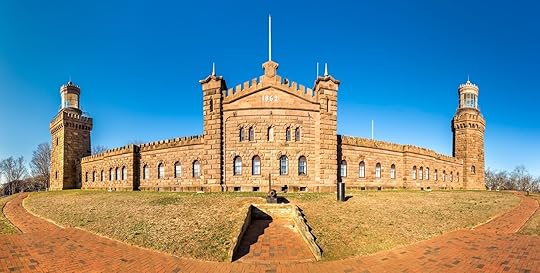
Photo: Mihai_Andritoiu/Shutterstock
Twin Lights is on the hills overlooking Sandy Hook Bay in Highlands. This historic lighthouse, open daily from 10 AM to 4 PM, is famed for several groundbreaking advancements: it was the first US lighthouse equipped with a Fresnel lens (concentric rings of glass prisms that capture and magnify light, allowing it to be visible over significantly longer distances), had one of the country’s earliest electrically illuminated beacons, and was the site of Guglielmo Marconi’s first practical demonstration of wireless telegraphy in 1899.
Visitors can explore the impressive double brownstone towers, built in 1862, and ascend 65 steps for breathtaking panoramic views of the coastline and surrounding area. Inside, the museum showcases a collection of artifacts from both the lighthouse and lifesaving station, including films and informative exhibits detailing the station’s storied past.
Although accessible year-round, a particularly exciting time to visit is during the annual Lighthouse Challenge, held on the third weekend in October, featuring exclusive tours and special events.
Twin Lights Lighthouse: 2 Light House Rd, Highlands, NJ 07732
…then continue to the Sandy Hook Lighthouse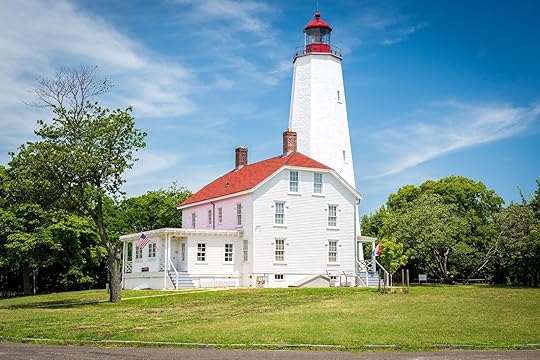
Photo: jvphoto.ca/Shutterstock
Sandy Hook Lighthouse is the oldest standing and continuously operating lighthouse in the US, located within the Sandy Hook Unit of Gateway National Recreation Area in Highlands. Constructed in 1764, it’s the only remaining tower of the 11 lighthouses built in the original 13 colonies. Today, visitors can explore this well-preserved landmark by joining a seasonal guided tour conducted by the National Park Service. Those eager to experience the breathtaking views from the top must be at least 48 inches tall and prepared to climb 95 stairs and a nine-rung ladder.
Tours depart from the Sandy Hook Visitor Center, and guests are encouraged to inquire about tour availability and scheduling, as these vary seasonally.
Sandy Hook Lighthouse: 84 Mercer Rd, Highlands, NJ 07732
Appreciate all things pumpkin at Happy Day FarmView this post on InstagramA post shared by Happy Day Farm | Agri-Tourism Destination (@happydayfarmnj)
A 130-acre, family-friendly destination, Happy Day Farm comes alive in the fall when visitors can enjoy pumpkin picking, shoot a pumpkin blaster, take part in carnival games, navigate intricately themed corn mazes (past themes include Snoopy, Marvel, and New Jersey-native celebrities), and capture memorable moments among the whimsical installations of Pumpkinville. In all, guests can take part in more than 35 activities and farm animal encounters during Fall Festival Days on weekends and Columbus Day.
Weekday visits offer a relaxed experience with pumpkin picking, tractor rides, and fields blooming with sunflowers and zinnias. Advance online tickets are required for weekend events, and bring cash as most activities and door tickets are cash-only.
Beyond fall, Happy Day Farm transforms throughout the seasons. Summer visitors can pick fresh berries — blueberries, raspberries, and blackberries — or stroll through fragrant lavender fields and blooming sunflowers and zinnias. Fresh-squeezed lemonade, shaved ice treats, and gemstone mining add to the summer charm.
Happy Day Farm: 106 Iron Ore Rd, Manalapan Township, NJ 07726
Explore the vintage shops and boutiques in Red Bank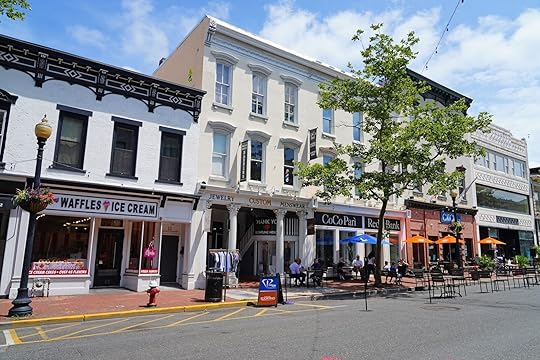
Photo: EQRoy/Shutterstock
This town of under 13,000 on the shore is known for its funky art scene, history, culture, and shopping. Start your afternoon by grabbing a lunch of flatbreads and burgers with a pint of craft beer at The Robinson Ale House, a local favorite known for its atmosphere.
Take a leisurely walking tour to admire beautifully preserved Victorian-era homes, stop by the historic and local favorite Dublin House pub, and enjoy serene views of the Navesink River at picturesque Riverside Gardens Park.
Or spend time at the more than 15 shops selling everything from antiques and collectables to jewelry and more at Monmouth Street Emporium. Stroll along Broad Street and hop into any boutiques, art galleries, and specialty stores that catch your eye. Don’t miss Jay & Silent Bob’s Secret Stash comic book store if you’re a fan or collector.
Round out your visit with a stop at JBJ Soul Kitchen, a non-profit community restaurant founded by the Jon Bon Jovi Foundation.
Catch a show at the Count Basie Center for the Arts
Photo: EQRoy/Shutterstock
Originally opened as the Carlton Theater in 1926, this 1,568-seat theater is listed on the National Register of Historic Places. The Basie has hosted legendary artists like Bruce Springsteen, Tony Bennett, Ringo Starr, and jazz icon William J. “Count” Basie himself, after whom the theater was renamed in 1984.
Esteemed for its acoustics, the Basie Center is beloved by performers — Tony Bennett called it his favorite place, while Art Garfunkel praised its unmatched sound quality. Today, the Count Basie Center for the Arts offers a broad array of performances ranging from classical symphonies and ballet to jazz, rock, and pop music. It also houses the Grunin Arts Education Building, home to the Turner Academy of the Arts, a classical conservatory, and The Vogel, an additional intimate performance space. Visitors can also enjoy the beautiful William J. and Catherine Basie Arts Plaza.
Count Basie Center for the Arts: 99 Monmouth St, Red Bank, NJ 07701
Where to eat and drink in Monmouth CountyOn the DeckOn the Deck delivers a taste of the Jersey Shore for lunch and dinner: traditional seafood and classic favorites served in a laid-back, waterfront atmosphere. Located near the Sea Streak Ferry terminal, this casual restaurant offers spectacular views of the marina, Gateway National Park, and the New York City skyline, making it one of the area’s best spots to enjoy stunning sunsets. The friendly vibe is perfect for groups who enjoy generous portions and well-made drinks from the full-service bar. The lobster salad and jumbo lump crab cakes are standout dishes not to miss, and if you visit on a Thursday, the prime rib special is highly recommended. Other favorites include the broiled seafood platter, brimming with fresh clams and shrimp in an irresistible lemon and garlic sauce, and the generously portioned decked pasta with ample lobster, scallops, and shrimp. On the Deck and its lively waterfront atmosphere thrives in the warmer months with both indoor and outdoor seating, though it remains a reliable, welcoming choice year-round.
On the Deck: 10 Simon Lake Dr, Atlantic Highlands, NJ 07716
McLoone’s Pier HouseView this post on InstagramA post shared by ' (@mcloones_pierhouse)
Since opening in 2005, McLoone’s Pier House is a celebrated oceanfront dining spot in Long Branch. With views of the Atlantic Ocean and indoor and outdoor dining, it’s equally special for a relaxed meal as a special celebration. The extensive menu features a raw bar with oysters and clams, crab cakes and calamari, and a sushi menu. Entrées span from classic steaks and steamed lobster to fish tacos.
McLoone’s Pier House: 1 Ocean Ave N, Long Branch, NJ 07740
Where to stay in Monmouth County: Wave Resort & SpaView this post on InstagramA post shared by Wave Resort (@waveresort)
Wave Resort & Spa is centrally located in Pier Village in Long Branch, making it perfectly located for exploring nearby attractions, from the iconic Monmouth Racetrack to adventures along the Jersey Shore to Asbury Park. Or, for the lighthouse enthusiasts among us, the resort can be a homebase for the annual Lighthouse Challenge.
Guest rooms and suites have private balconies to fully immerse you in the sights and sounds of the Atlantic Ocean. Dining here is a highlight in itself. Choose from casual, quick bites at Bubbi’s Bagels and LBK Grill, or indulge in cocktails and elevated bites at The Bar, Carousel Bar, and the seasonal swim-up Pool Bar — oceanfront views included, of course. During cooler months, cozy outdoor fire pits and seasonal beverages at the Carousel Bar provide warmth and ambiance.
While the location makes it easy to get out and explore (take advantage of the complimentary beach cruisers from the hotel concierge), you’ll want to do at least some of your relaxation and wellness at Wave Resort Spa. There are restorative treatments from massages and body scrubs to CBD and aromatherapy options. Complement your spa experience with visits to the state-of-the-art fitness center with Peloton bikes and modern exercise equipment overlooking the picturesque pool deck. Outdoor seasonal fitness classes, yoga sessions, and watersports provide ample opportunities to stay active while enjoying the ocean breeze.
Waves Resort & Spa: 110 Ocean Ave, Long Branch, NJ 07740
Getting to and around Monmouth CountyGetting here is easier than it seems. Visitors flying in can use Newark Liberty International Airport (EWR), which is just under an hour’s drive to the coast. For those coming from New York City, the SeaStreak Ferry offers a direct and scenic route to Atlantic Highlands or Highlands that comes with skyline views (and no traffic). From there, it’s a short drive to most of the county’s cultural and coastal destinations. 
July 18, 2025
Bubblegum Soda, Fried Rice, and Unexpected Fusion: Peru’s Chifa Food Culture

I first learned about Chifa food in Lima, Peru, while tired and ravenous, wandering the streets of Barrio Chino (Chinatown) with jet lag and no plan. I followed the scent of sizzling garlic and soy to a small restaurant with red lanterns in the window and enough fluorescent lighting to qualify as a Vitamin D supplement.
I ordered arroz chaufa, which sounds like “chifa” with an extra syllable, and a neon yellow soda called Inca Kola – something the server assured me was “very Peruvian.” The rice arrived steaming, packed with egg, scallions, and soy-marinated chicken. I took one bite, and followed it with a sip of soda that tasted like bubblegum and nostalgia. The combo felt like half kung fu movie, half telenovela. It was unexpected, bold, and weirdly perfect. This, I learned, is the embodiment of Chifa food, Peru’s Chinese-Peruvian fusion cuisine.

Photo: Rina Ermakova/Shutterstock
When most people are dreaming of Peruvian food, they’re likely picturing well-known dishes like ceviche, quinoa, creamy aji de gallina, and potatoes served in a hundred — or perhaps a thousand — different ways. All are delicious and well worth a plane ticket. But also available is Chifa, a flavor-packed tradition that might surprise most travelers.
Chifa is the love child of Cantonese cooking and Peruvian ingredients, born in immigrant kitchens and seasoned in sizzling pans that never take a day off. It’s also not some niche trend: Chifa is everywhere. From corner joints with red plastic chairs and laminated menus to upscale spots with mood lighting and craft cocktails, Chifa is part of Peru’s culinary DNA. It’s soy sauce kissed with ají amarillo. It’s fried rice with attitude (and chorizo). It’s the kind of food that makes you wonder why you hadn’t heard about it sooner.

Photo: Guillermo Spelucin R/Shutterstock
Chifa’s story begins in the late 1800s, when thousands of Chinese laborers were sent to work on plantations and railroads in Peru. They brought their culinary traditions and ingredients with them, like rice, soy sauce, ginger, and wok cooking. However, they had to fill in the rest of the gaps with what was available. Bok choy became cabbage. Local peppers and herbs joined the mix. What emerged was a new kind of cooking rooted in home, shaped by circumstance, and adapted with Peruvian soul.
The name Chifa comes from the Cantonese phrase chi fan, meaning “to eat rice.” Over time, it came to refer to both the cuisine and the restaurants themselves. By the early 20th century, Chifa spots were popping up all over Lima. What started as comfort food for the Chinese community became a staple for everyone.
Various sources claim the uncited but consistent number of about 6,000 Chifa restaurants in Lima alone. That’s more than coffee shops in New York City, and without the need for complicated drink orders.

A casual Chifa restaurant in Peru. Photo: Christian Vinces/Shutterstock
Chifa hasn’t stood still. While many restaurants still serve giant portions of rice, noodles, and dumplings with casual flair, others have brought Chifa to the world of white tablecloths and tasting menus.
Some chefs are digging into traditional techniques and regional Chinese flavors, while others are mixing in Nikkei (Japanese-Peruvian) influences or Amazonian ingredients. Now, you can find dumplings with Peruvian herbs like huacatay and sacha culantro, or bao buns with Andean cheese. It’s like a remix of a remix, and it works.
You can now find Chifa-inspired dishes in New York, Madrid, even Vancouver. It’s spreading, evolving, shapeshifting, but always keeping its wok-fired heart.
View this post on InstagramA post shared by Gaston Acurio (@gastonacurio)
Peru takes its food seriously. The country has become a culinary destination, thanks to chefs like Gastón Acurio, who helped turn Peruvian cuisine into a passport stamp for food lovers. And while ceviche gets the magazine covers, Chifa is what’s on the table when the cameras are put away.
“What makes Chifa important in our Peruvian food culture is the influence,” says Leidy Huaman Tello, a Lima-based food tour guide at M&A LuxExperiences who shares the history of Peru’s cuisine with travelers. She says the fact that it’s something you can only find in Peru makes it a source of pride. “That’s why Chifa is so loved,” she says. “It isn’t 100 percent Chinese food. It’s a fusion that plenty of the Peruvian population enjoys, even people who don’t eat traditional Chinese food.”
Chifa isn’t flashy, but it delivers. It’s the loyal friend of Peruvian food culture, always showing up, always feeding you well, and never judging your third helping.
You don’t need to order everything on the menu to fall in love with Chifa – just order one of these dishes.
Arroz chaufa is Peru’s iconic fried rice. It’s made with scallions, egg, soy sauce, and either meat or seafood, and is a balance of savory and comforting. It’s considered a gateway dish into Chifa cuisine.
Lomo saltado

Photo: Lina chero Photography/Shutterstock
Lomo saltado is stir-fry with beef, onions, tomatoes, and fries — yes, fries — in soy sauce and vinegar. It’s always served with rice. It’s Chifa-meets-home-cooking and totally addictive.
Kam lu wantán is fried wontons topped with a tamarind and ginger sauce and stir-fried vegetables. Sometimes, it’s also topped with sweet-and-sour pork or chicken tossed with shrimp. It’s one of the most popular Chifa dishes in Peru and is full of colors and textures, aptly reflecting the fusion behind Chifa cuisine.
Sopa wantán

Photo: Toyakisphoto/Shutterstock
This warm, slurp-worthy broth with pork dumplings, egg, and green onions is on most Chifa restaurant menus. It’s the kind of hearty, comforting soup that fixes things, even if you didn’t know you needed fixing.
Chi jau kay and tipakay
Chi jau kay (sometimes spelled chijaukai) is chicken in savory soy-based sauce, while tipakay is its sweeter cousin. Pair them with arroz chaufa, and you’ll send your taste buds on a well-balanced joyride. Both dishes hit the right mix between sweet and savory in the same bite – something unusual in many cuisines, but not uncommon with Chifa food.
Whether you seek it out in a tiny neighborhood joint or a sleek modern kitchen, Chifa is worth an extra night in the country – or even an entire trip, especially if you’re a traveling foodie. Just make sure you bring an appetite – and a thirst for Inca Kola. 
Matador Network's Blog
- Matador Network's profile
- 6 followers



